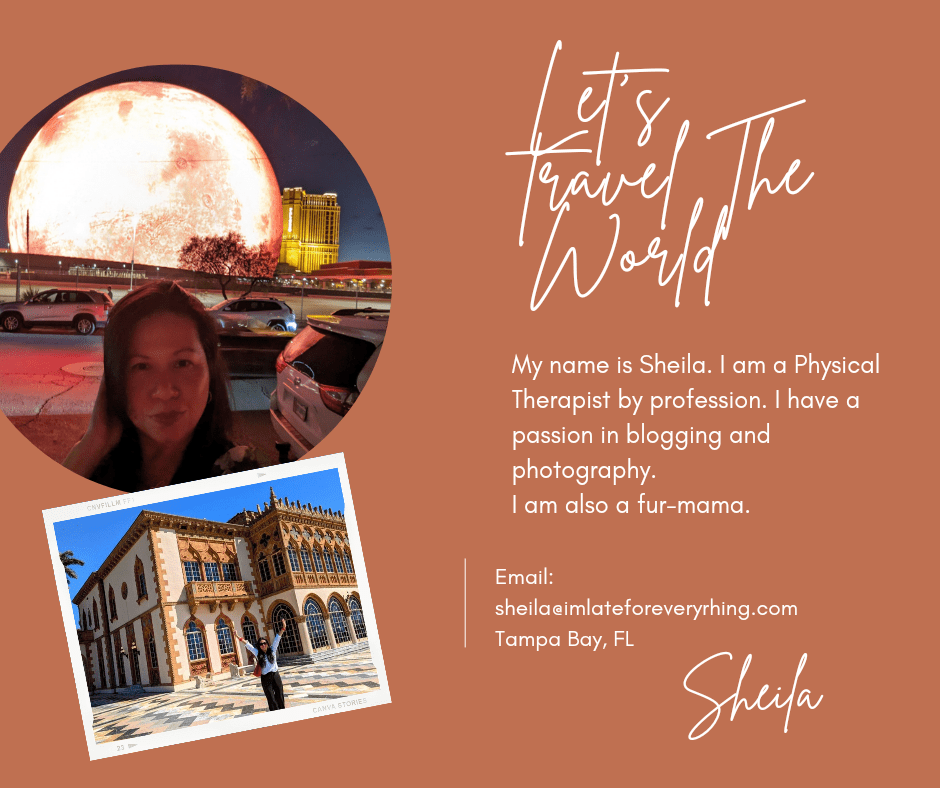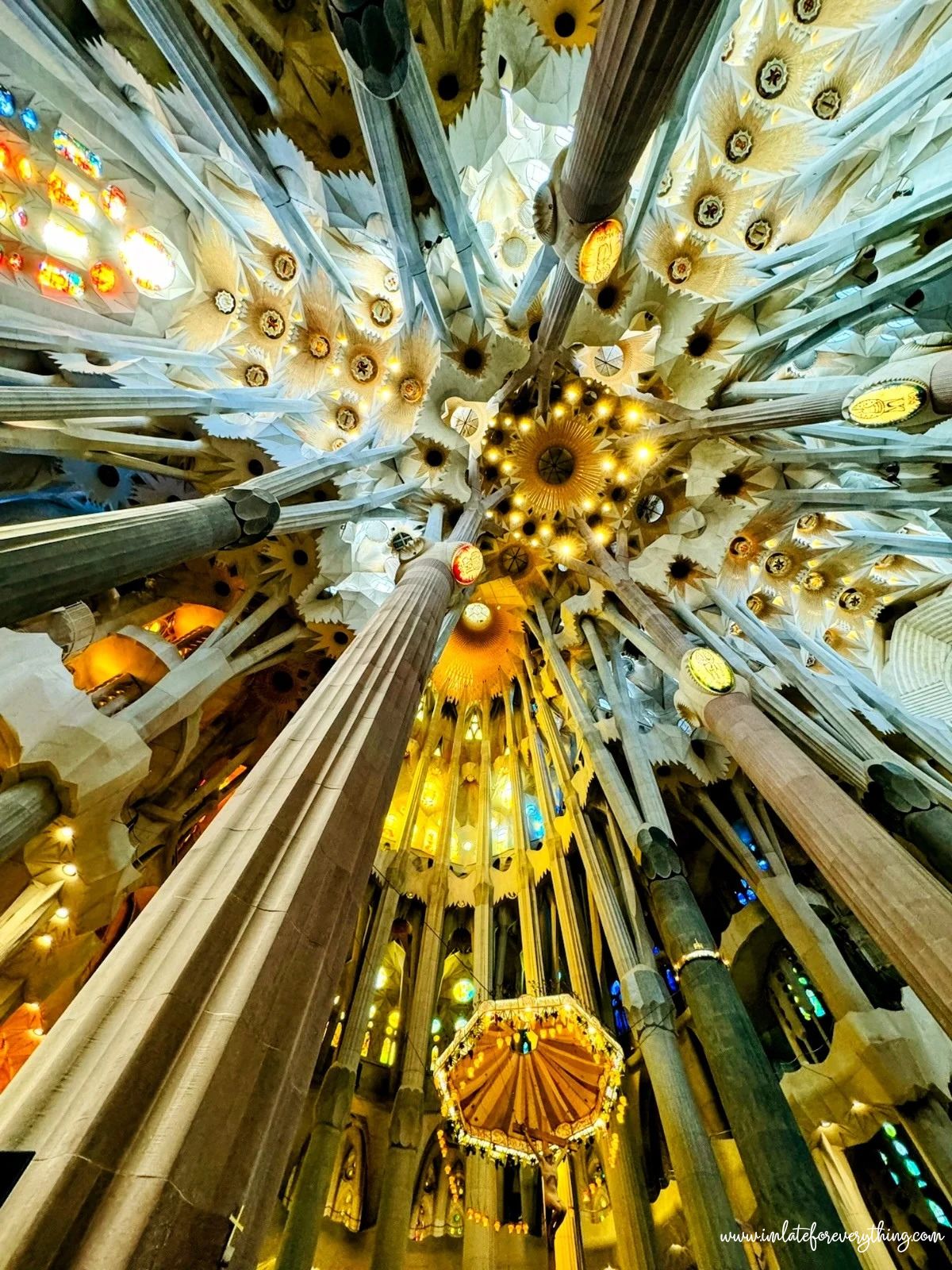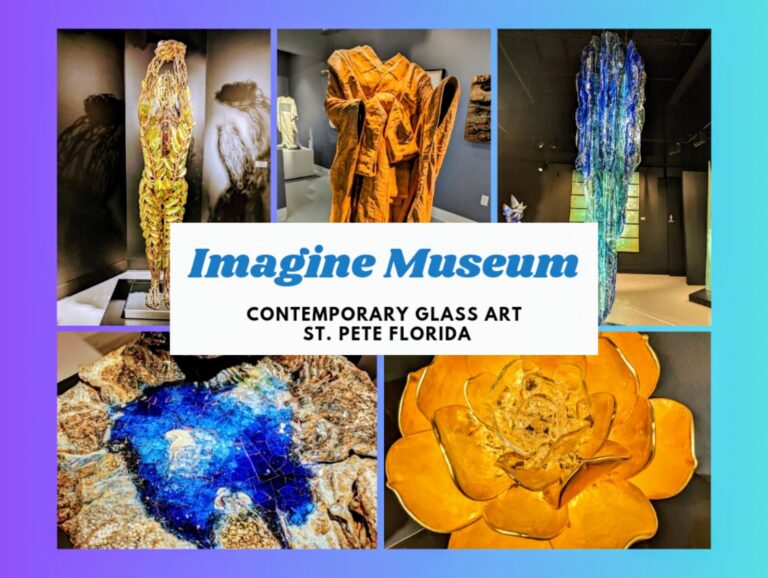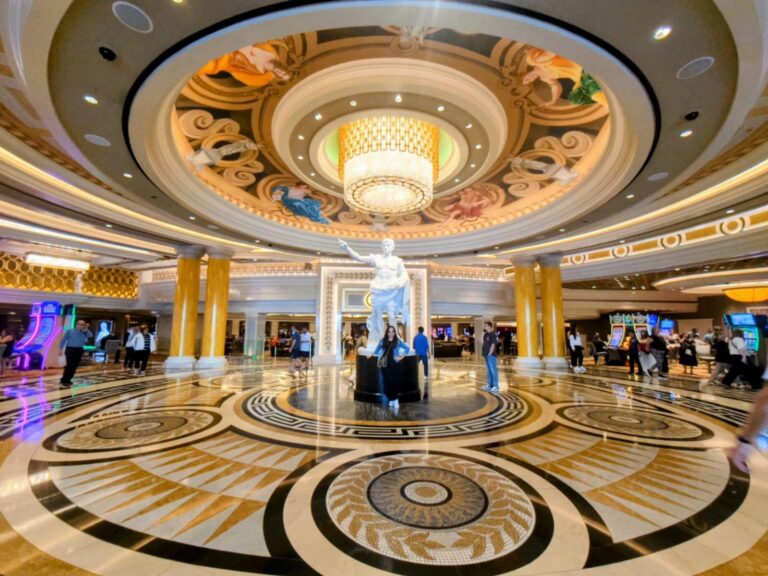25 Most Beautiful Church Ceilings In The World
Churches have long been symbols of faith, culture, and architectural innovation. Among the most captivating aspects of these sacred structures are their ceilings, which often serve as canvases for breathtaking art and intricate designs. Let’s explore the 20 most beautiful church ceilings in the world, each a masterpiece in its own right.
I know there’s a lot of most beautiful church ceilings in the world and it’s hard to decide which are most beautiful, but for me these church ceilings stands out. Also I am thinking of putting part 2 as I see more beautiful church ceilings photos.
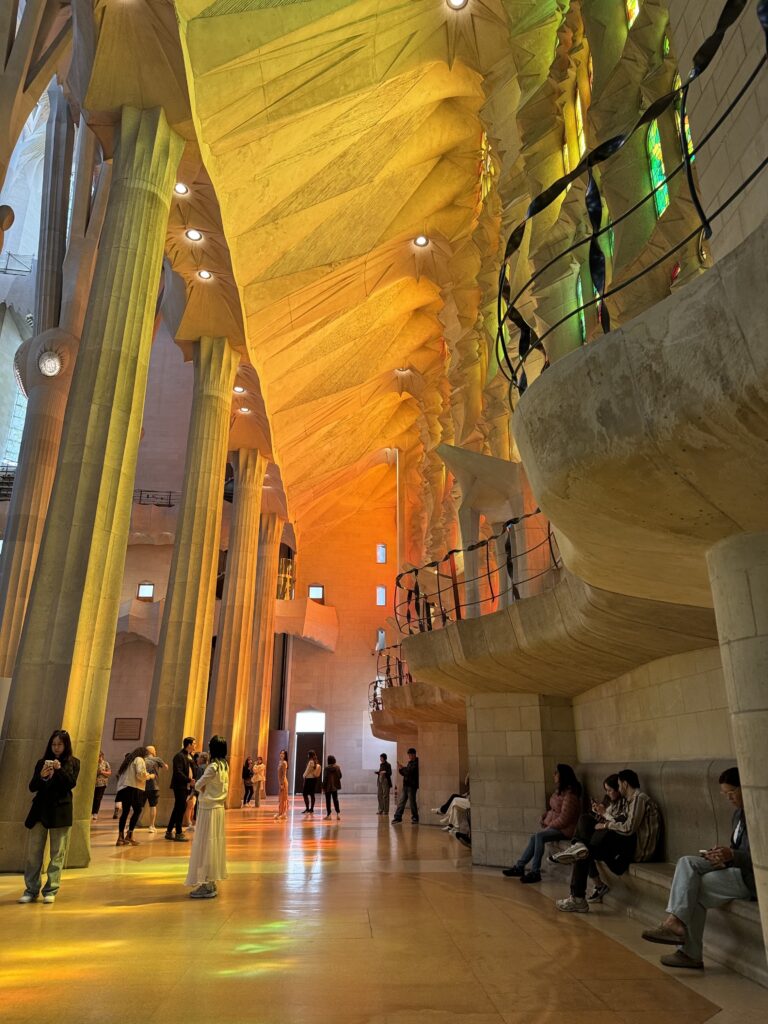
I have a deep fascination with architecture and design, especially when it comes to the intricate details of ceilings, the grandeur of buildings, and the beauty of various architectural styles. From historic cathedrals to modern marvels, I am captivated by the artistry and craftsmanship that goes into creating these magnificent structures and hope to more of these in person.
Words of the day:
FRESCO – the art of painting on freshly spread moist lime plaster with water-based pigments ( on a wall or ceiling ) Merriam Webster.
MOSAIC – a decoration on a surface made by setting small pieces of glass, tile, or stone of different colors into another material so as to make pictures or pattern. Merriam Webster.
Bucket List And Travel Ideas:
As a photographer enthusiasts and blogger these most beautiful church ceilings in the world photos inspires me to travel more and take my photography to another level. This blog is part of my bucket list and travel ideas, most photos here are free images and thanks to great photographers of Unsplash & Pexels and I’m just putting them together to inspire you to get out there, travel and enjoy life!!
“Join me as I explore and celebrate the world of architecture, sharing insights, stunning visuals, and stories behind some of the most beautiful buildings and their exquisite ceilings. Here’s some great travel ideas for you guys. And don’t forget to add these most beautiful churches ceilings in your bucket list and because why not!! “

25 Most Beautiful Church Ceilings In The World
1. Sistine Chapel, Vatican City
Michelangelo’s Masterpiece
The Sistine Chapel ceiling, painted by Michelangelo between 1508 and 1512, is perhaps the most renowned church ceiling in the world. The frescoes depict scenes from the Book of Genesis, including the iconic Creation of Adam. It is located inside the Vatican Museum.
Historical Significance: The Sistine Chapel is one of the most renowned chapels in the world, located within Vatican City. It serves as the official residence of the Pope and is the site of the papal conclave, where new popes are elected.
Architectural Style: The chapel was built between 1473 and 1481 by architect Giovanni dei Dolci for Pope Sixtus IV, after whom it is named. It features a simple rectangular design, reflecting the architectural style of the period.
Ceiling Structure: The ceiling of the Sistine Chapel is famously adorned with frescoes painted by Michelangelo between 1508 and 1512. This monumental work of art depicts a series of biblical scenes, including the iconic Creation of Adam, where God and Adam’s fingers nearly touch.
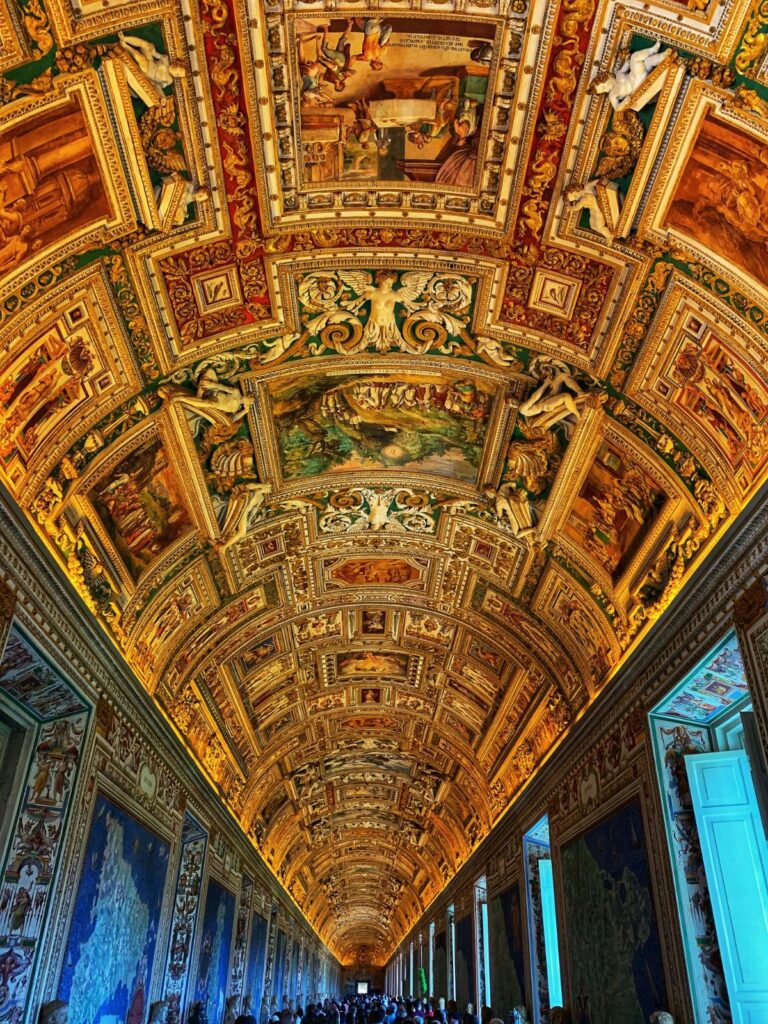

Click here to buy tickets to skip the line: Tiqets
2. St. Peter’s Basilica, Vatican City
Baroque Splendor
Historical Significance: St. Peter’s Basilica, located in Vatican City, is one of the most important and largest churches in the world. It is traditionally believed to be the burial site of Saint Peter, one of Jesus’s apostles and the first Pope. The basilica was constructed over several centuries, with contributions from some of the greatest artists and architects of the Renaissance and Baroque periods, including Michelangelo, Bramante, and Bernini.
Architectural Style: The basilica is a masterpiece of Renaissance and Baroque architecture. Its design combines elements from both styles, characterized by its grandiose scale, harmonious proportions, and the extensive use of domes and colonnades.
Ceiling Structure:
- Central Dome: The most iconic feature of St. Peter’s Basilica is its massive central dome, designed by Michelangelo. The dome rises to a height of 136.5 meters (448 feet), making it one of the tallest in the world. The interior of the dome is adorned with mosaics that depict biblical scenes and saints, created by a team of artists under Michelangelo’s direction. The dome is supported by four massive piers and is topped with a lantern that allows light to filter into the basilica, enhancing the spiritual atmosphere.
- Vaulted Ceilings: The nave and transepts of the basilica feature vaulted ceilings decorated with intricate stucco work and gilded details. The coffered ceilings are designed to add depth and dimension to the vast interior space, contributing to the overall grandeur of the basilica.
- Frescoes and Mosaics: The ceilings and vaults are richly decorated with frescoes and mosaics that depict scenes from the Bible, the lives of saints, and various religious allegories. The use of vibrant colors and intricate designs reflects the artistic brilliance of the Renaissance and Baroque periods.
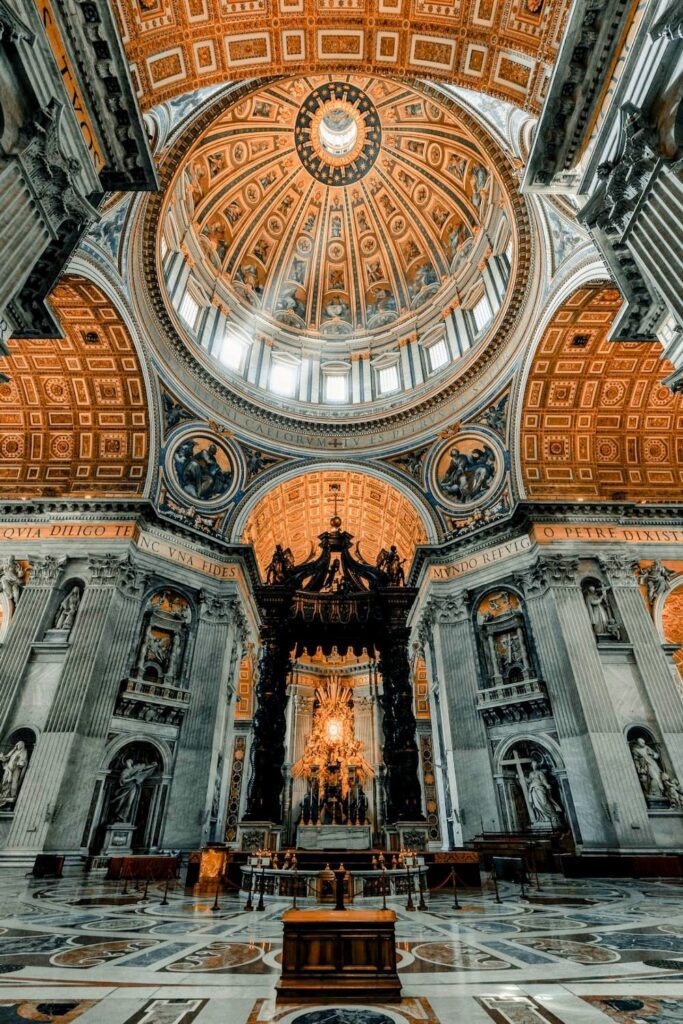
Booking.com offers a great deals with flights and hotels.
Booking.com offers a great deals with flights and hotels. Book Now.


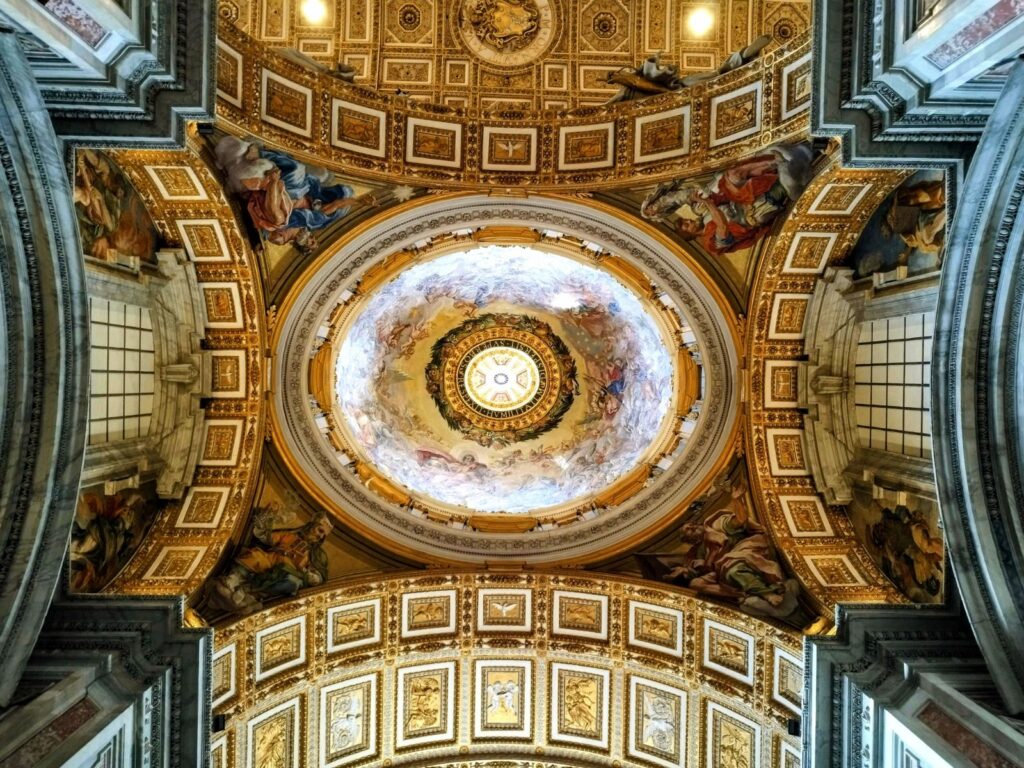
3. Cathedral of Santa Maria del Fiore, Florence, Italy
Brunelleschi’s Dome
Historical Significance: The Cathedral of Santa Maria del Fiore, commonly known as the Florence Cathedral or the Duomo, is one of the most iconic landmarks in Florence, Italy. It was designed by Arnolfo di Cambio and began construction in 1296, with its completion taking nearly 140 years. The cathedral is renowned for its architectural innovation, artistic grandeur, and its role in the history of Florence during the Renaissance.
Architectural Style: The Duomo is a prime example of Italian Gothic architecture, later incorporating elements of Renaissance style. The exterior is adorned with intricate marble panels in shades of green, pink, and white, and the structure features elaborate carvings, statues, and decorative elements.
Ceiling Structure:
- Dome (Cupola): The most remarkable feature of the Florence Cathedral is its massive dome, designed by Filippo Brunelleschi. Completed in 1436, it was an engineering marvel of its time and remains the largest masonry dome ever constructed. The dome is octagonal in shape and consists of two shells: an inner shell for structural support and an outer shell for protection. The innovative use of a herringbone brick pattern and horizontal reinforcements allowed for the dome’s unprecedented size and stability.
- Frescoes: The interior of the dome is adorned with a stunning fresco, “The Last Judgment,” painted by Giorgio Vasari and Federico Zuccari between 1572 and 1579. The fresco covers approximately 3,600 square meters and depicts scenes of heaven and hell, angels and demons, and various biblical figures. The vibrant colors and dramatic composition create a breathtaking visual experience.
Cultural and Religious Importance: The Florence Cathedral is not only a place of worship but also a symbol of the city’s artistic and architectural heritage. It has played a central role in Florence’s religious, cultural, and social life for centuries. The cathedral, along with its dome and accompanying structures like the baptistery and Giotto’s Campanile, is a major tourist attraction and a UNESCO World Heritage site.
I love using GetYourGuide to check for beautiful places, their website is really cool to fins places and things to do. You can buy tickets of the tours and attractions. It’s a great travel guide.



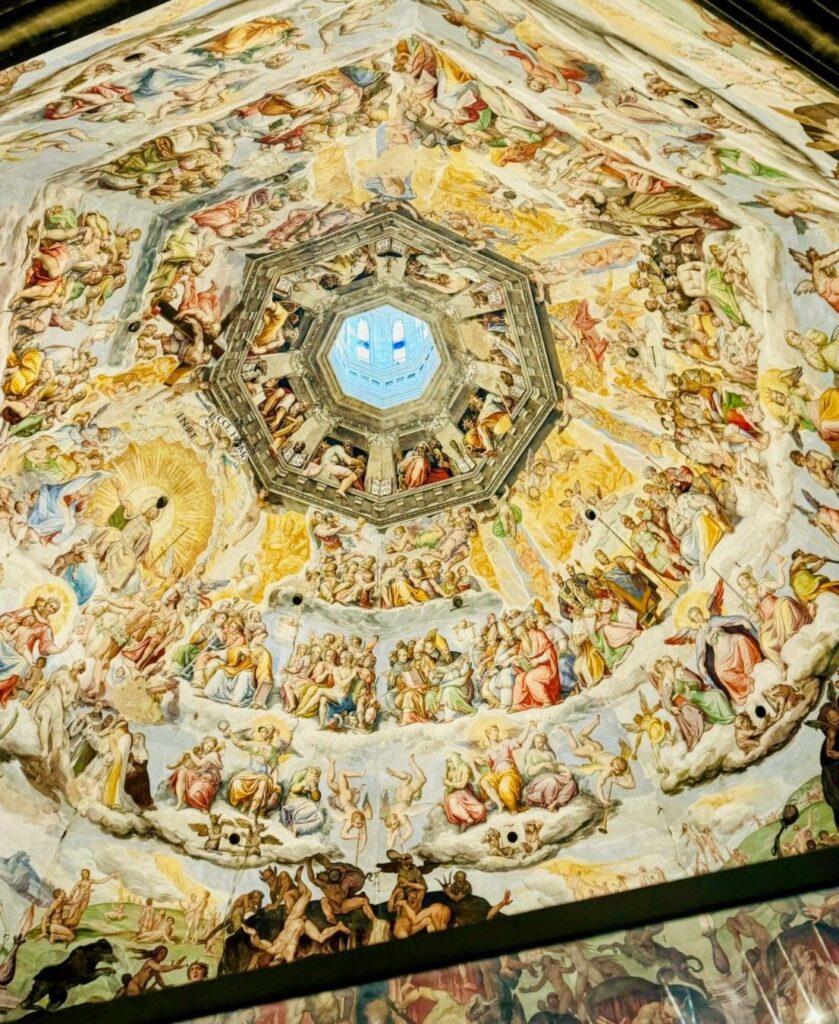
Related Article: 15 Most Beautiful Places To Visit In Paris
4. Church of St. Ignatius of Loyola, Rome, Italy
Illusionistic Fresco
Andrea Pozzo’s ceiling fresco in the Church of St. Ignatius of Loyola is a marvel of Baroque illusionism, depicting the saint ascending to heaven, with architectural elements that blend seamlessly into the real structure.
Historical Significance: The Church of Saint Ignatius of Loyola, also known as Chiesa di Sant’Ignazio di Loyola, is a magnificent Baroque church located in Rome, Italy. It was built between 1626 and 1650 to honor Saint Ignatius of Loyola, the founder of the Society of Jesus (Jesuits). The church was designed by the Jesuit architect Orazio Grassi.
Architectural Style: The church is a prime example of Baroque architecture, characterized by its grandiose and dramatic style. It features a richly decorated façade, a spacious nave, and a series of chapels adorned with art and sculptures.
Ceiling Structure: Frescoed Ceiling: The most remarkable feature of the Church of Saint Ignatius of Loyola is its breathtaking frescoed ceiling, created by the Baroque painter Andrea Pozzo. The fresco, titled “Triumph of Saint Ignatius of Loyola,” was completed between 1685 and 1694 and is one of the most famous examples of trompe-l’œil (trick of the eye) art.
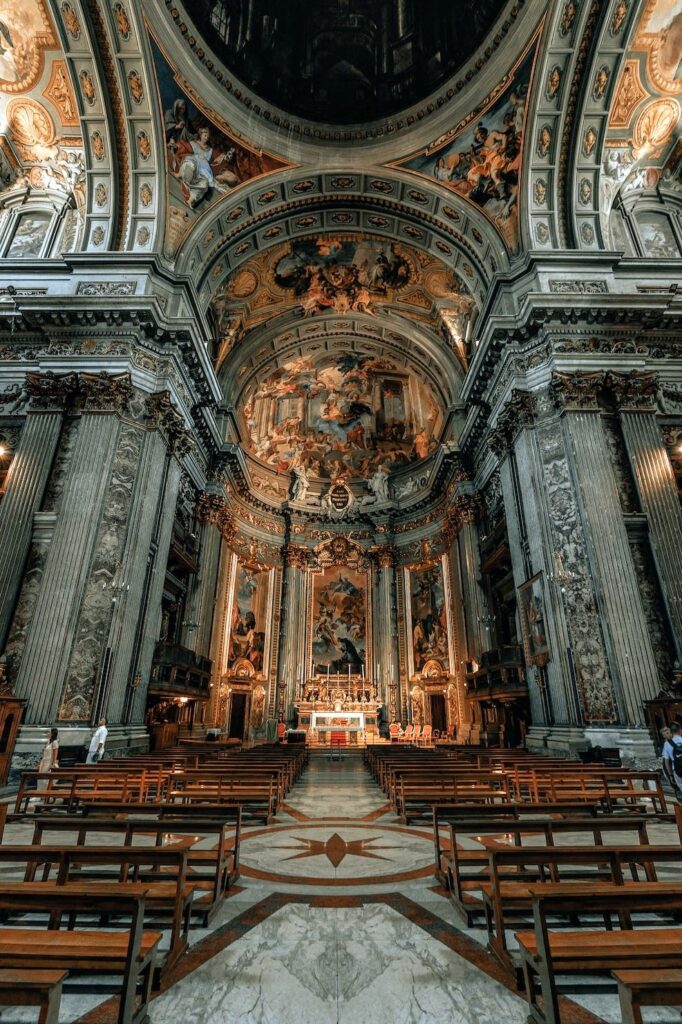
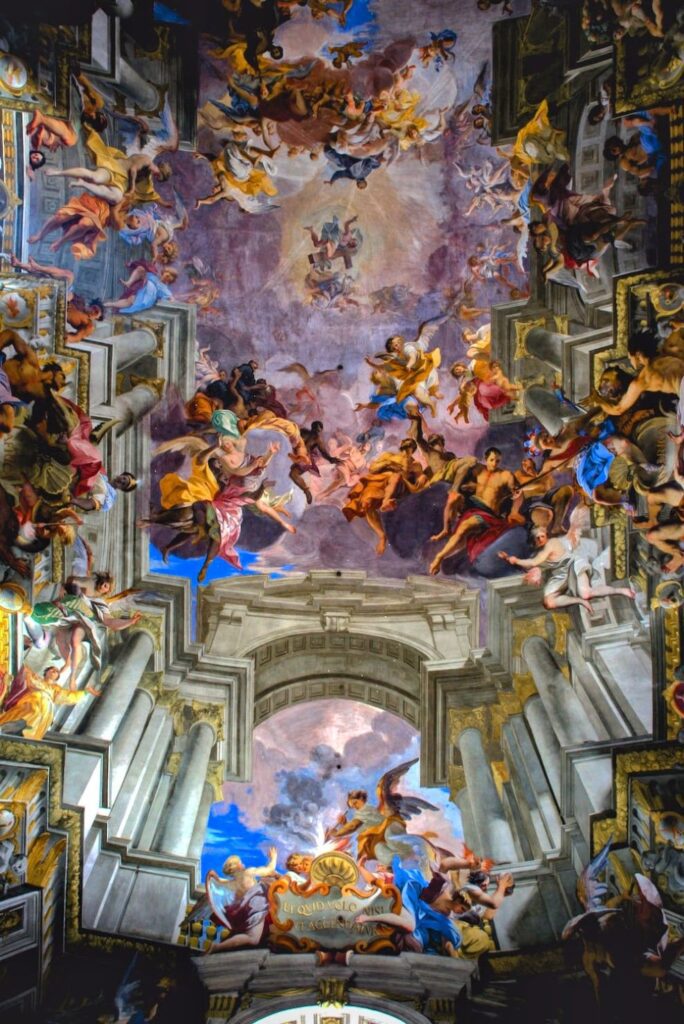
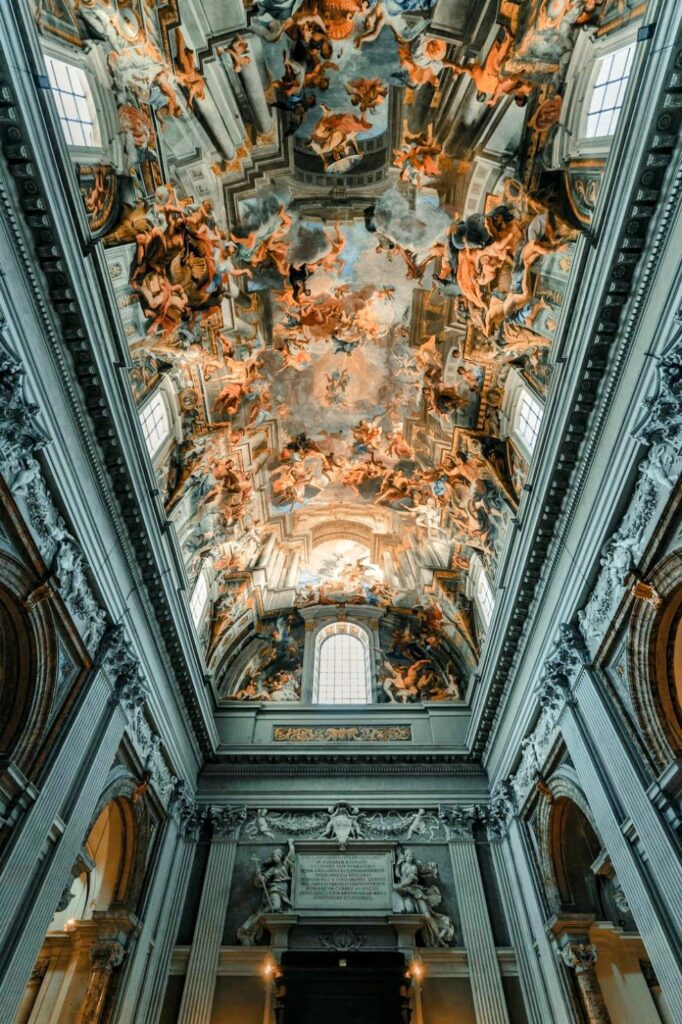
TripAdvisor is also my “go to” website to read reviews about my next destination. They have this ” All you must know before you go ” article of every places and it is very helpful. Tickets are reasonable too. If you wanna skip the line you can grab your tickets at Tiqets.
5. St. Paul’s Cathedral, London, England
Wren’s Architectural Genius
Sir Christopher Wren’s masterpiece in St. Paul’s Cathedral features a magnificent dome with an interior decorated with mosaics and paintings that highlight the grandeur of the Anglican cathedral.
Historical Significance: St. Paul’s Cathedral is one of the most iconic landmarks in London, England. It has been the site of many significant events in British history, including the funerals of Lord Nelson and Sir Winston Churchill, the wedding of Prince Charles and Lady Diana Spencer, and various jubilee celebrations for Queen Elizabeth II. The current cathedral, designed by Sir Christopher Wren, was completed in 1710 after the previous building was destroyed in the Great Fire of London in 1666.
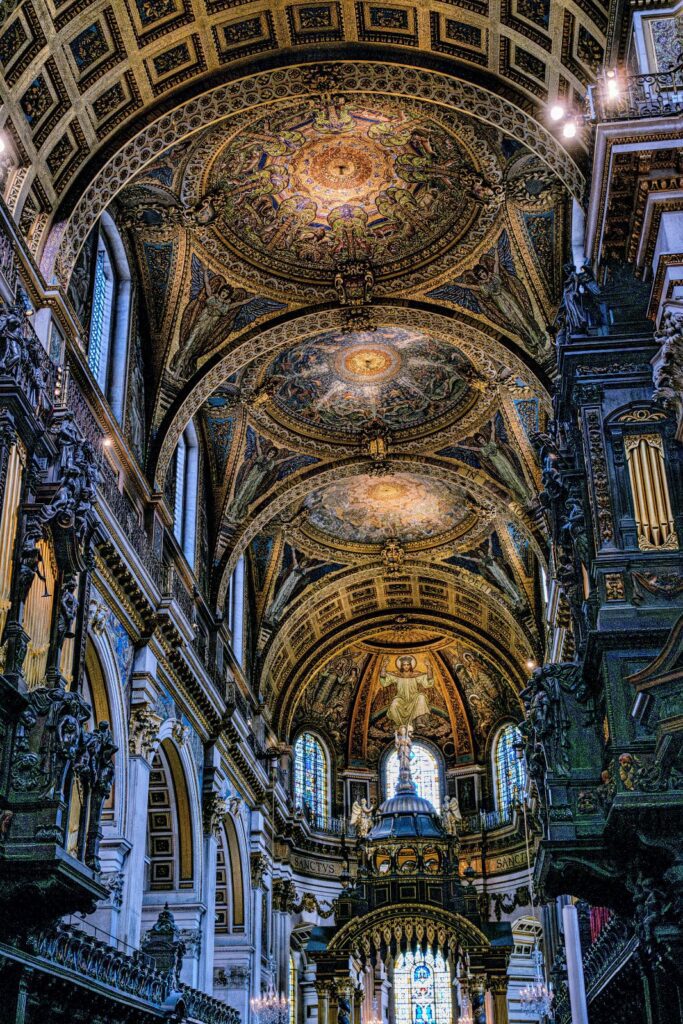
Popular Travel Article: Best Hotel Lobbies in Vegas
6. Washington National Cathedral, Washington, D.C.
Gothic Revival Brilliance: The ceiling of the Washington National Cathedral is an exemplary representation of Gothic Revival architecture. Here are some key features ribbed vaulting, stone carvings and stained glass windows.
Historical Significance: The Washington National Cathedral, formally known as the Cathedral Church of Saint Peter and Saint Paul, is an iconic Gothic Revival cathedral located in Washington, D.C. It is the sixth largest cathedral in the world and the second largest in the states and serves as the Episcopal Church’s cathedral and a house of prayer for all people. The cathedral is an important national landmark, hosting numerous state events, presidential funerals, and public services. Construction began in 1907 and was completed in 1990, with significant contributions from various architects and artisans.
Architectural Style: The cathedral is designed in the Gothic Revival style, inspired by the great medieval cathedrals of Europe. It features pointed arches, ribbed vaulting, flying buttresses, and intricate stone carvings. The exterior is adorned with gargoyles, statues, and a massive central tower.
Ceiling Structure: Nave Vaulting: The nave of the Washington National Cathedral features a magnificent ribbed vault ceiling. The ribs form a crisscross pattern that not only adds structural support but also creates a visually stunning effect. The vaulting allows for a sense of height and grandeur, directing the viewer’s gaze upwards towards the heavens
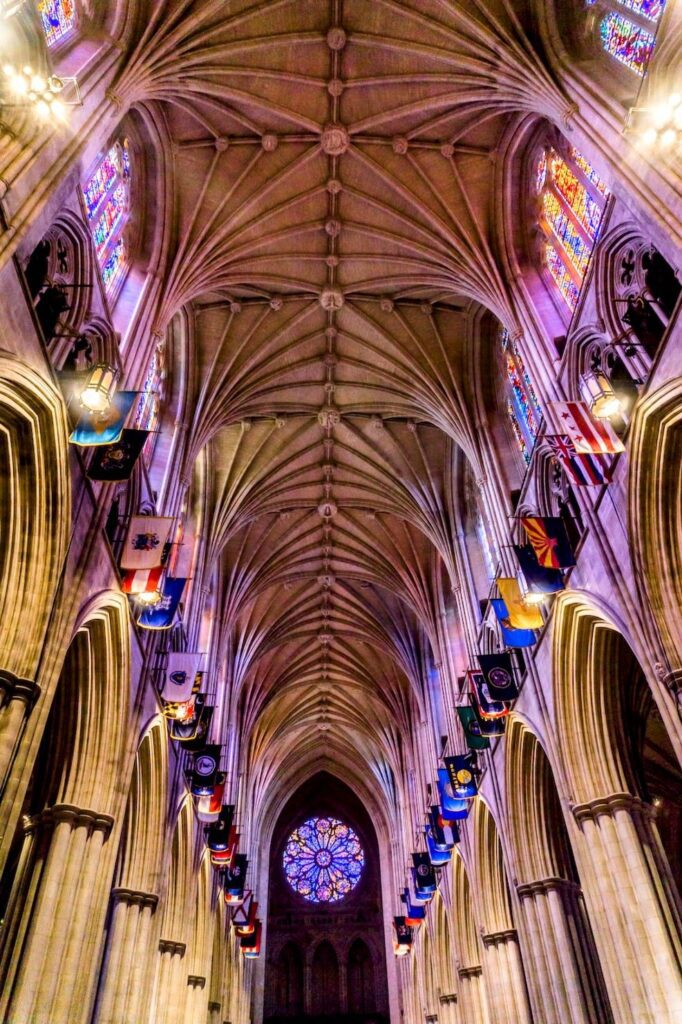
The cathedral has ” Special Night Light, Holiday Lights Special, daily sightseeing tour “ Click here to check their events and buy tickets. Washington National Cathedral Calendar of Events.
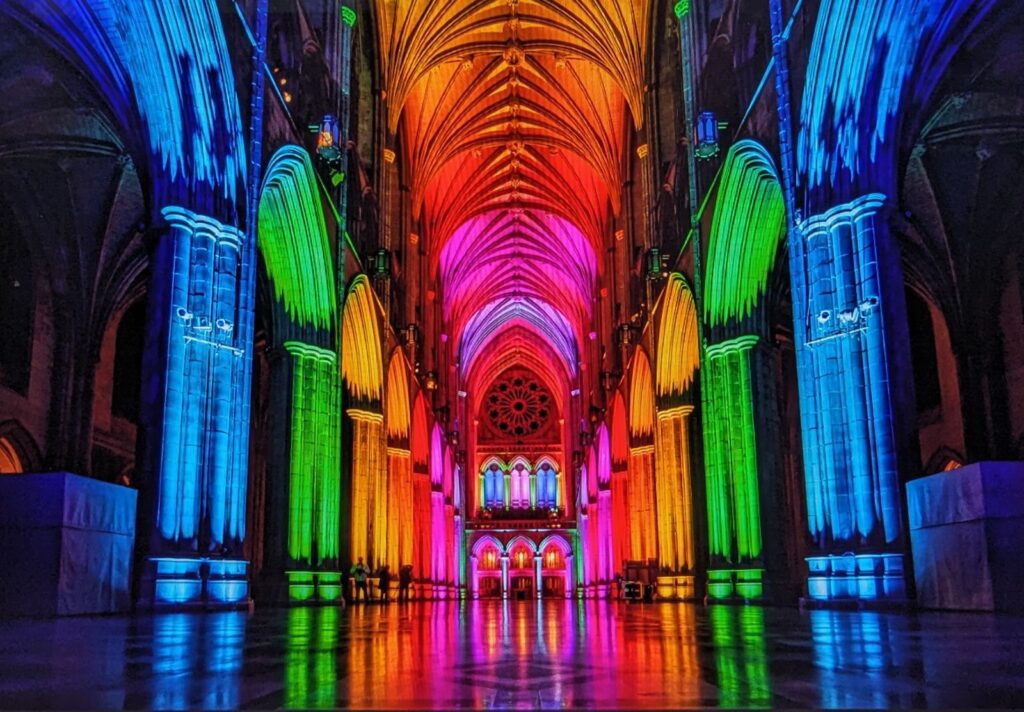
7. Basilica of Santa Maria Maggiore, Rome, Italy
Rich Historical Significance: The Basilica of Santa Maria Maggiore is one of Rome’s four major basilicas and boasts a rich history dating back to the 5th century.
Magnificent Ceiling: The ceiling, designed by Giuliano da Sangallo, is a masterpiece of Renaissance art. It features intricate gilded wooden panels, reportedly using gold brought back from the New World by Christopher Columbus. The ceiling’s elaborate design and the use of gold give it a luminous and opulent appearance, symbolizing the heavenly glory and grandeur of the church.
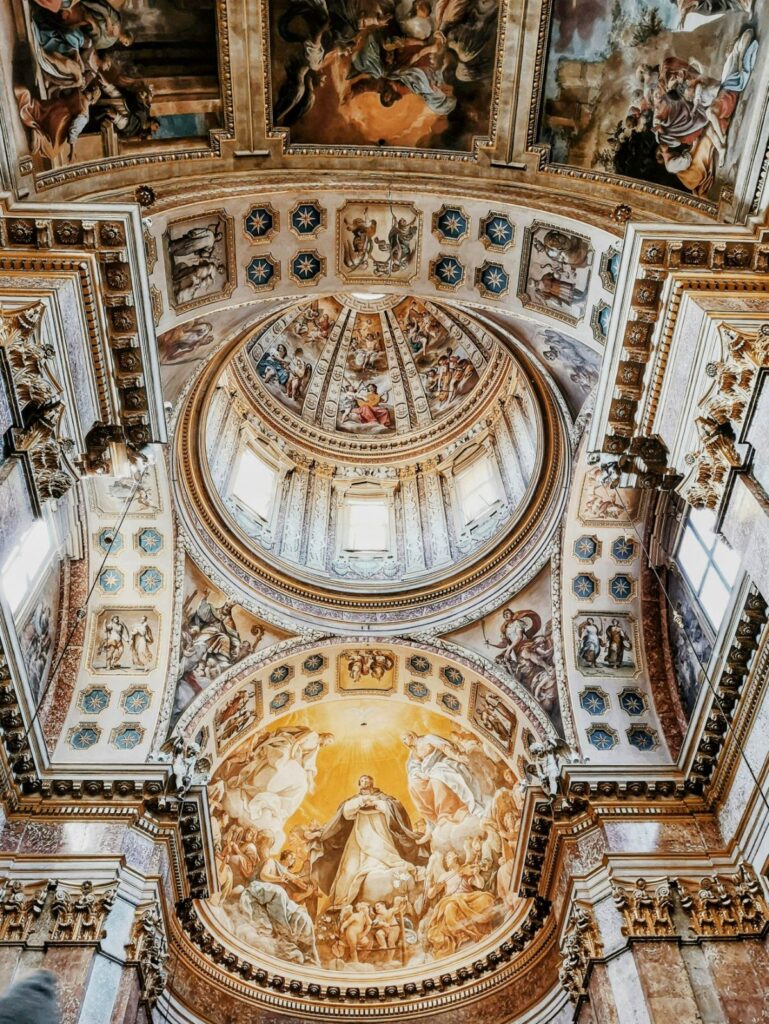
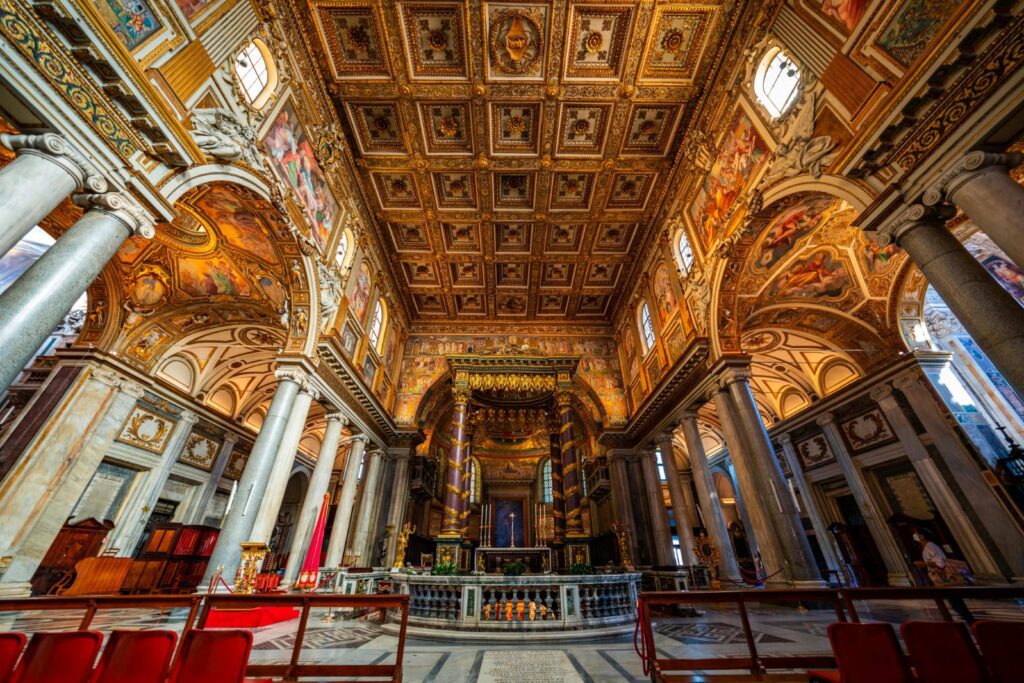
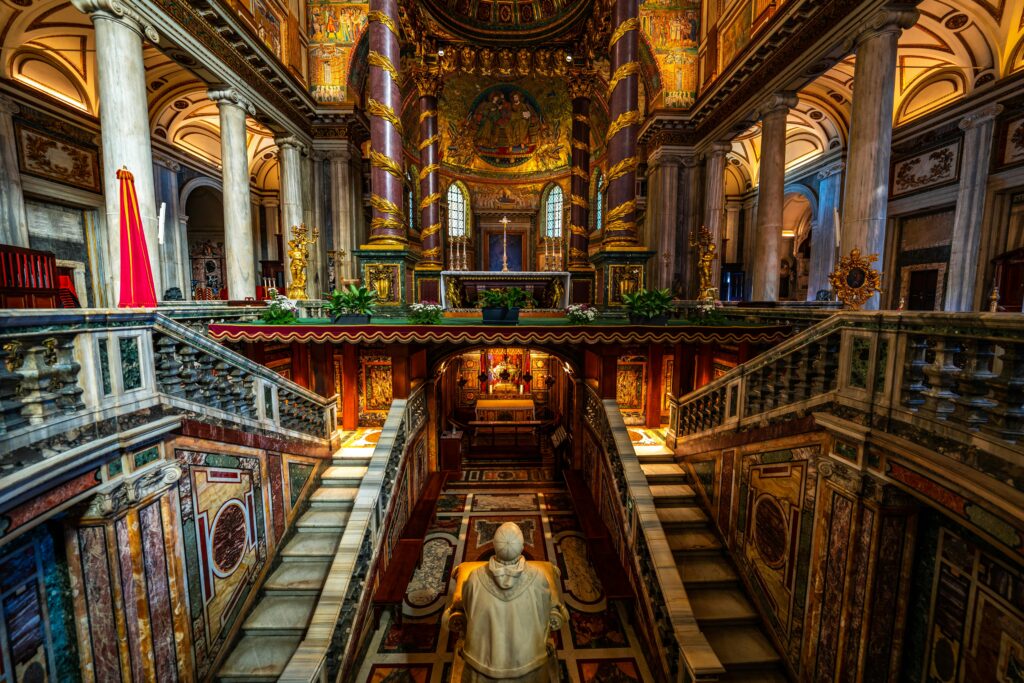
Baptistry Basilica Santa Maria Maggiore
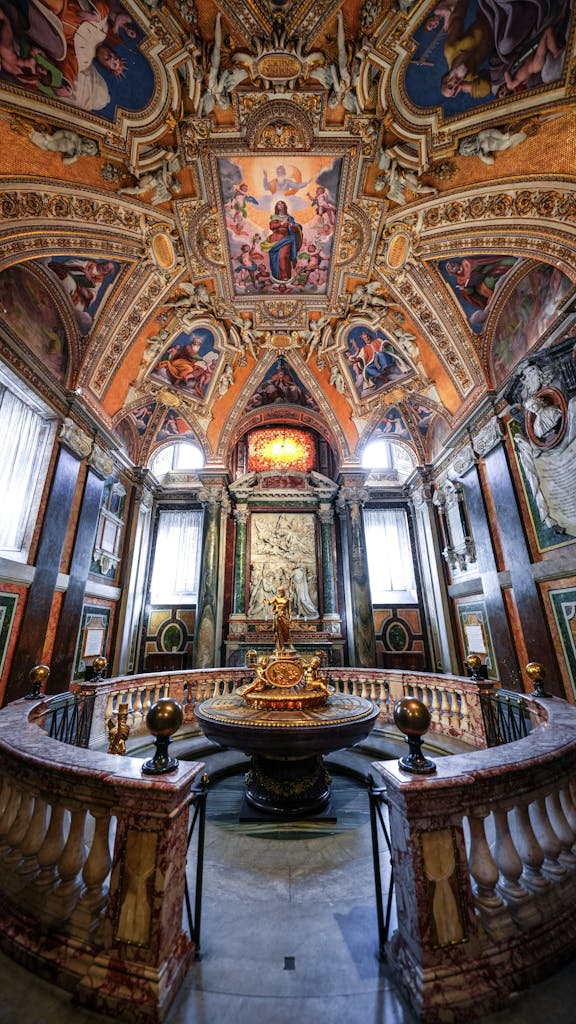
8. Church of the Savior on Spilled Blood, St. Petersburg, Russia
Unique Russian Revival Architecture: The Church of the Savior on Spilled Blood is an architectural marvel in St. Petersburg, built on the site where Emperor Alexander II was assassinated.
Spectacular Ceiling Mosaics: The interior of the church is adorned with one of the largest collections of mosaics in the world, covering over 7,500 square meters. The ceiling is particularly breathtaking, featuring intricate mosaics that depict biblical scenes, saints, and religious icons. The vibrant colors and detailed artistry create a sense of awe and reverence, making it one of the most visually stunning church interiors.
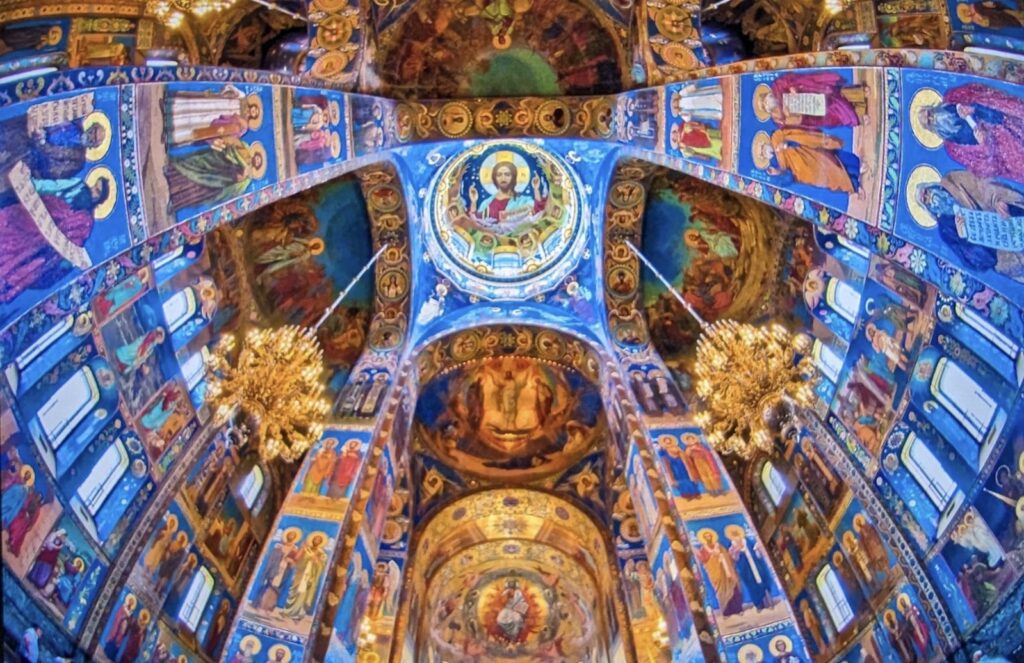
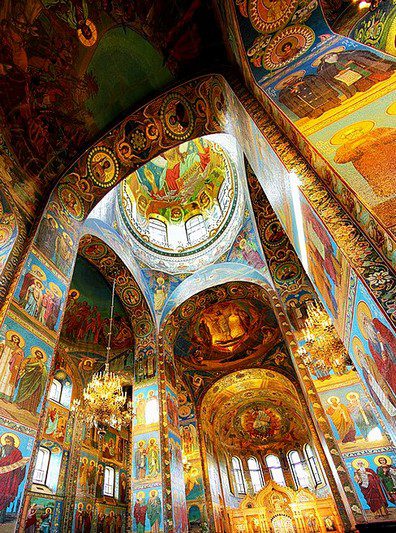
This is definitely one of the churches I would love love to visit someday in Russia. Wow!! What a beauty!! Have you heard about this church?
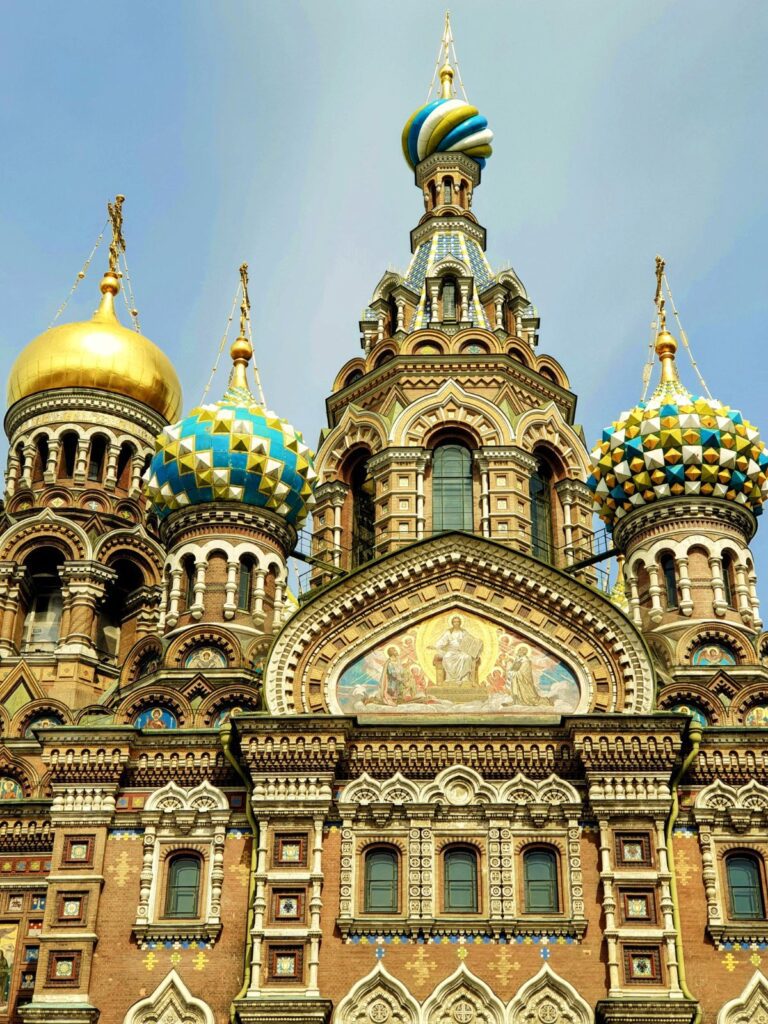
9. Cathedral of Notre-Dame, Paris, France
Icon of French Gothic Architecture: The Cathedral of Notre-Dame is a masterpiece of Gothic architecture, located on the Île de la Cité in Paris, France. It is still temporarily closed.
Magnificent Ceiling: The cathedral’s ceiling is characterized by its ribbed vaults and soaring heights, typical of Gothic design. It features intricate stone tracery and stained glass windows that fill the interior with colored light, creating a heavenly atmosphere. Despite the tragic fire in 2019, efforts to restore and preserve this historic ceiling continue, ensuring future generations can marvel at its grandeur.
The Cathedral of Notre-Dame’s ceiling is a testament to medieval craftsmanship and spiritual inspiration, captivating visitors with its architectural beauty and religious significance.
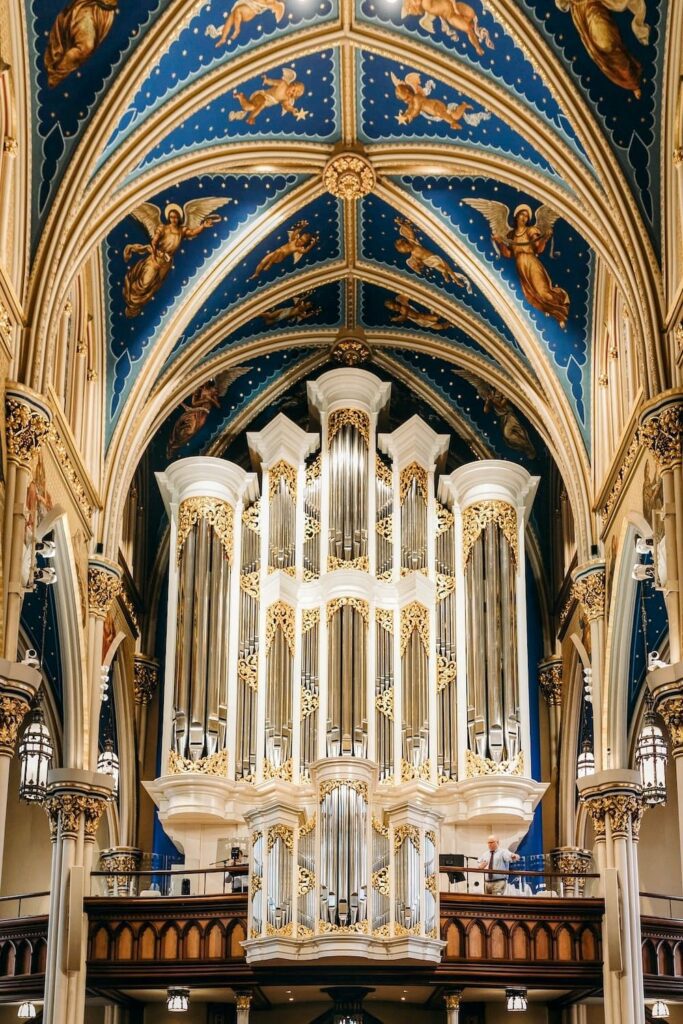
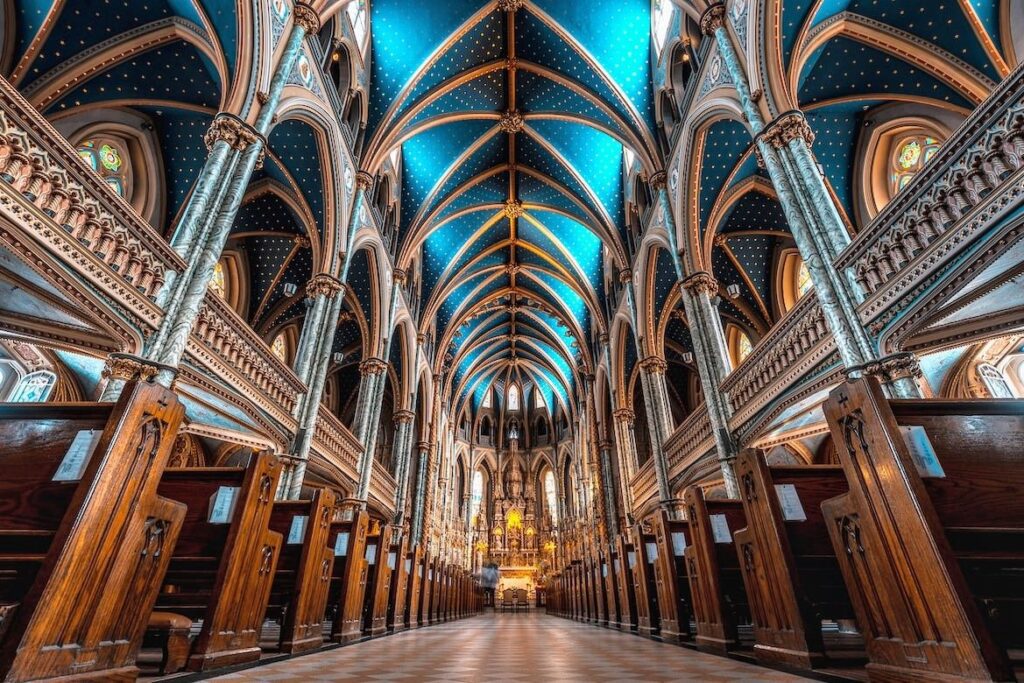
10. Sainte-Chapelle, Paris, France
Gothic Architectural Jewel: Sainte-Chapelle, located in Paris, is a masterpiece of Gothic architecture built in the 13th century by King Louis IX.
Exquisite Ceiling and Stained Glass: The chapel’s upper level is renowned for its stunning stained glass windows, which stretch almost entirely from floor to ceiling. These 15 towering windows depict biblical scenes and stories, creating a breathtaking kaleidoscope of color and light inside the chapel. The ceiling itself is adorned with delicate ribbed vaults and intricate stone tracery, adding to the ethereal beauty and spiritual ambiance of the space.
Historical Significance: Originally built to house precious relics, including the Crown of Thorns, Sainte-Chapelle remains a symbol of medieval Parisian grandeur and religious devotion. Its architecture and artistry continue to inspire awe and admiration among visitors from around the world.
Sainte-Chapelle’s ceiling and stained glass are unparalleled examples of Gothic artistry and remain a must-see for anyone interested in medieval architecture and religious history.
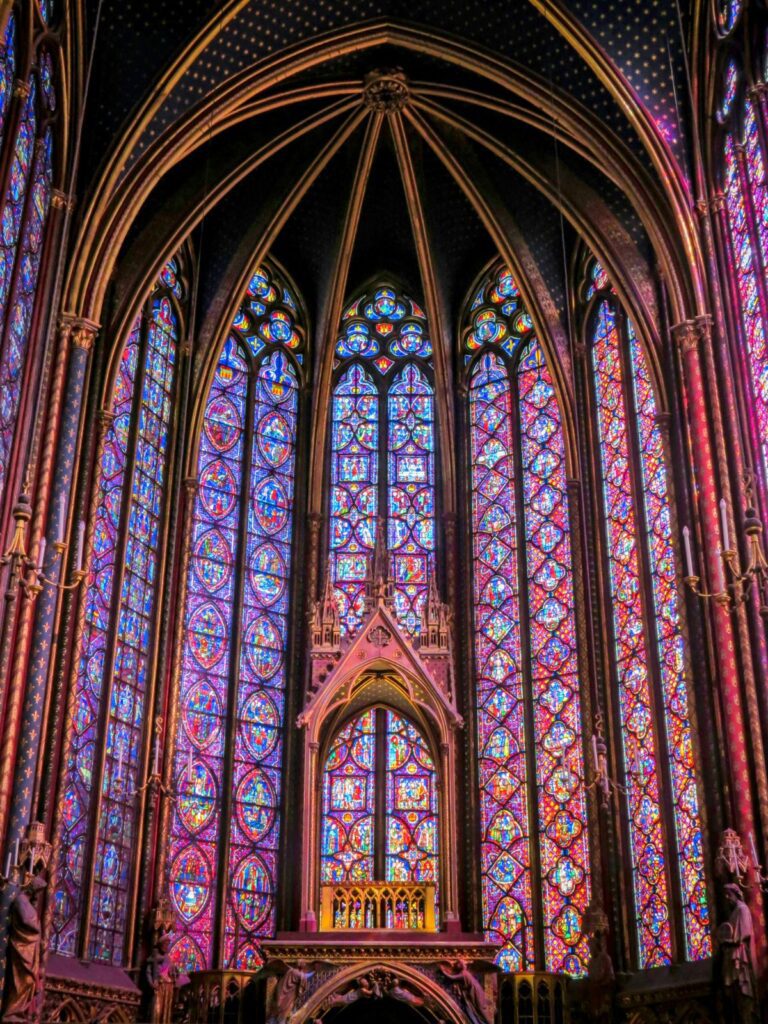

Check out the cheap deals at cheap0air.
11. St. Mark’s Basilica, Venice, Italy
Venetian Byzantine Majesty: St. Mark’s Basilica, situated in the heart of Venice, is a masterpiece of Byzantine architecture and one of the city’s most iconic landmarks constructed in 1904.
Intricate Ceiling Mosaics: The interior of St. Mark’s Basilica is adorned with breathtaking mosaic artwork covering an area of over 8,000 square meters. The ceiling is a spectacular display of these mosaics, featuring scenes from the life of Christ, the Virgin Mary, and various saints. The gold backgrounds and vibrant colors of the mosaics create a radiant and celestial atmosphere within the basilica, reflecting Byzantine opulence and religious symbolism.
Architectural Marvel: The Basilica’s architecture includes five domes and numerous marble columns, showcasing a blend of Eastern and Western influences. The intricate details and rich history make St. Mark’s Basilica a testament to Venice’s cultural and religious heritage.

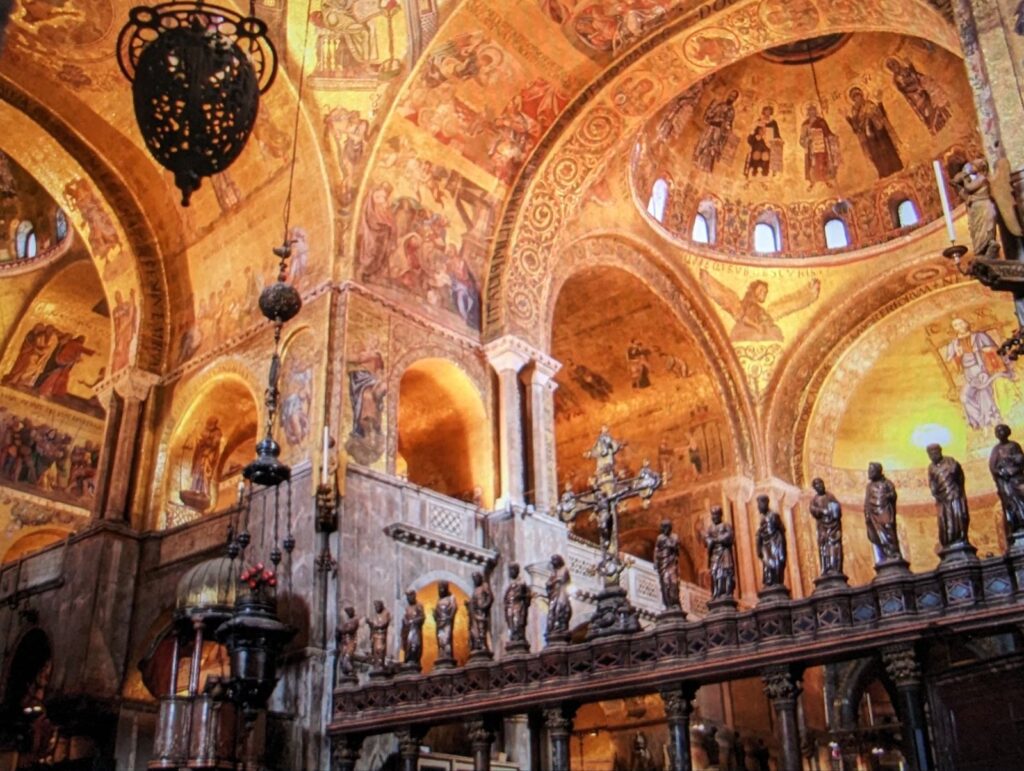
12. Temple of Saint Sava, Belgrade, Serbia
Symbol of Serbian Orthodoxy: The Temple of Saint Sava is one of the largest Orthodox churches in the world, located in Belgrade, Serbia. It is dedicated to Saint Sava, the founder of the Serbian Orthodox Church.
Architectural Splendor: The temple’s construction began in 1935 and continues to this day, making it a monumental work in progress. It is designed in the Serbian-Byzantine architectural style, characterized by its grand dome and monumental size.
Ceiling and Interior: While the Temple of Saint Sava is still under construction and its interior decoration is ongoing, the planned interior will feature intricate frescoes and mosaic decorations typical of Orthodox churches. The main dome, once completed, will likely be adorned with colorful frescoes depicting religious scenes and saints, reflecting the rich artistic tradition of Serbian Orthodox iconography.
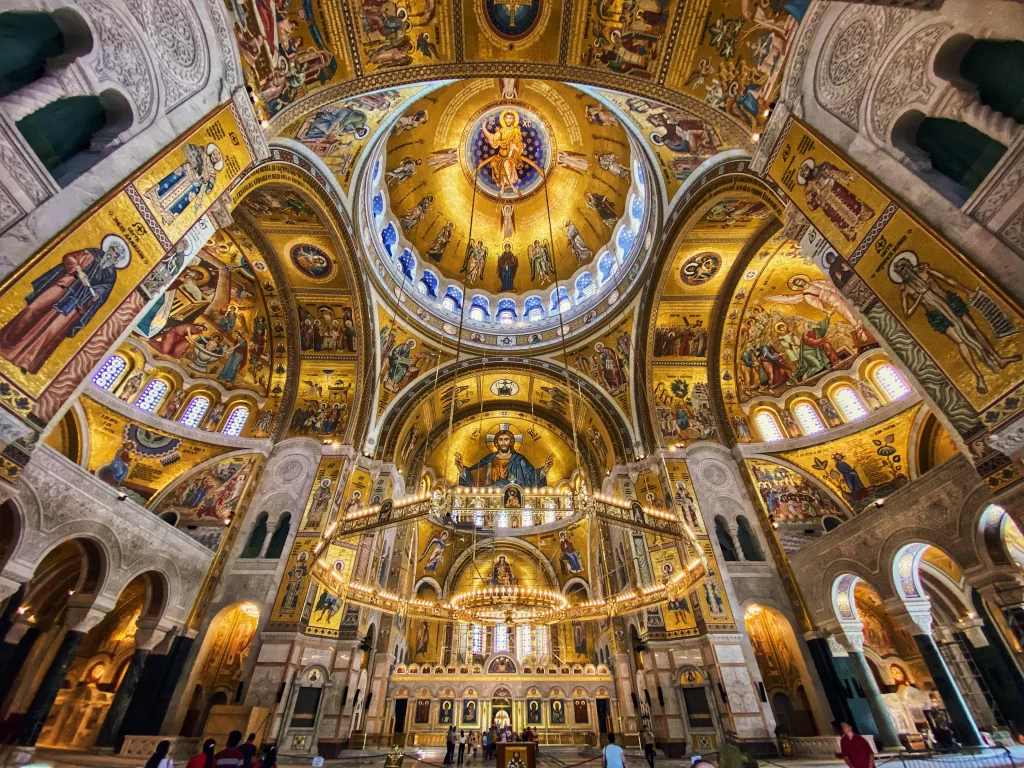
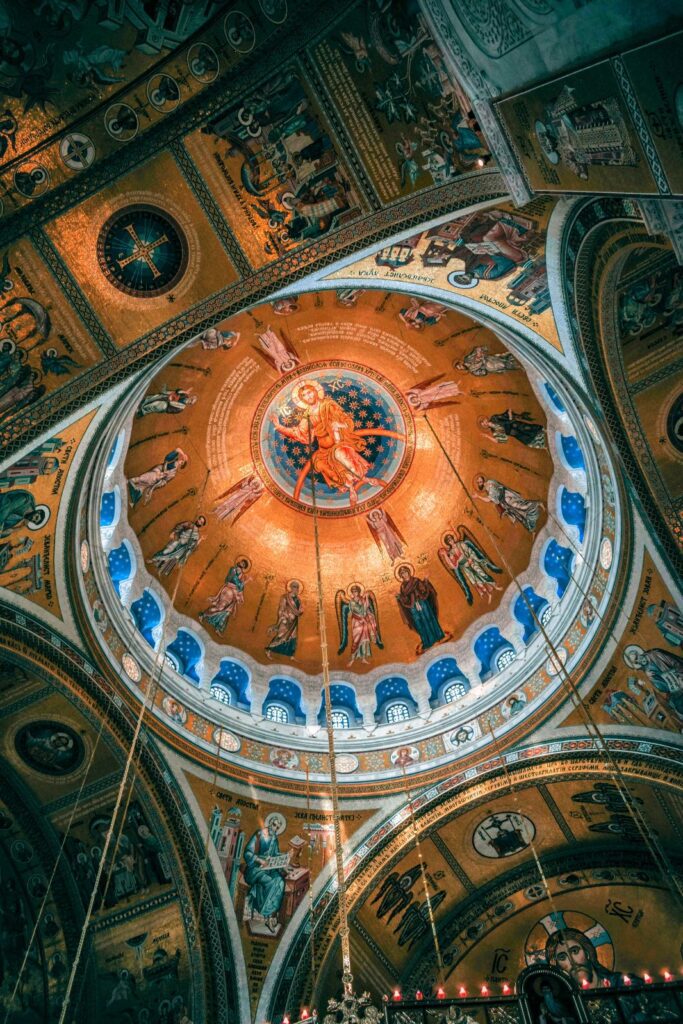

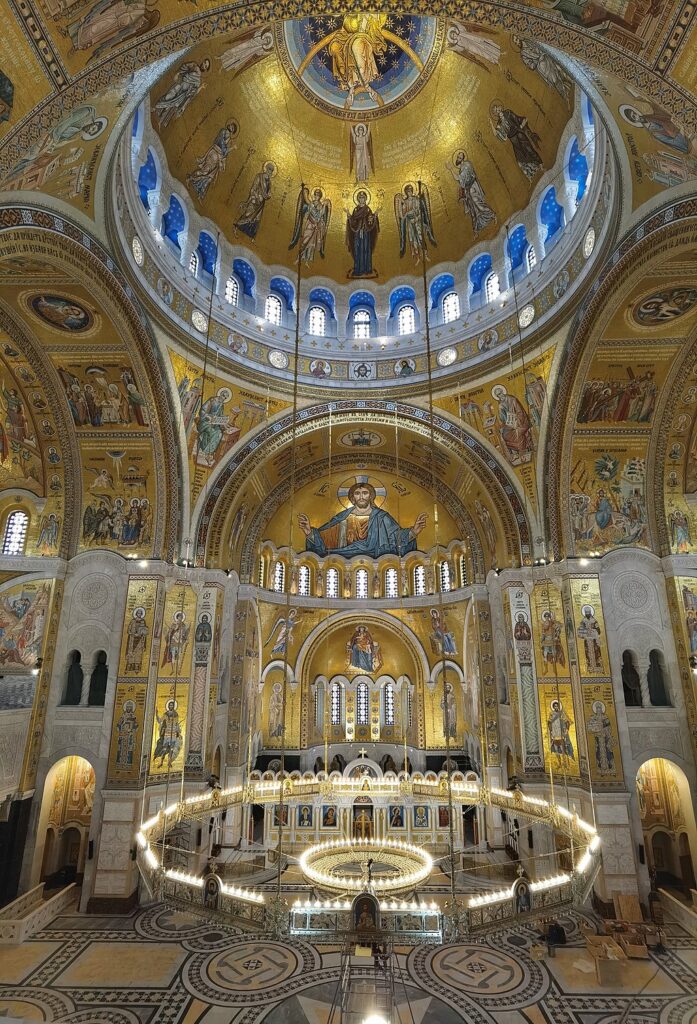
13. Santa Iglesia Catedral Basílica de la Encarnación, Málaga, Spain
Historical Significance: The Santa Iglesia Catedral Basílica de la Encarnación, commonly known as the Málaga Cathedral, is a prominent Roman Catholic church located in Málaga, Spain. The cathedral was built on the site of a former mosque after the Reconquista, when Málaga was reconquered by the Catholic Monarchs, Ferdinand and Isabella, in 1487. Construction of the cathedral began in the early 16th century and continued for over 200 years, resulting in a blend of architectural styles, primarily Renaissance and Baroque.
Architectural Style: The Málaga Cathedral features a blend of Gothic, Renaissance, and Baroque architectural styles due to its prolonged construction period. The façade, primarily Baroque, is richly decorated with statues and ornate carvings. The interior is predominantly Renaissance, characterized by its harmonious proportions and elegant detailing.
Ceiling Structure:
- Vaulted Ceilings: The cathedral’s interior features a series of impressive vaulted ceilings. The nave and aisles are covered by ribbed vaults, which are characteristic of Gothic architecture. These vaults create a sense of height and grandeur, drawing the eye upwards.
- Dome of the Main Chapel: One of the most striking features of the cathedral is the dome over the main chapel (Capilla Mayor). This dome is decorated with intricate plasterwork and frescoes that depict various religious themes. The use of light and color in the dome’s decoration enhances the sense of space and divinity within the cathedral.
- Coffered Ceilings: The cathedral also features several coffered ceilings, particularly in the side chapels. These ceilings are adorned with intricate geometric patterns and gilded details, reflecting the influence of Renaissance art and design.
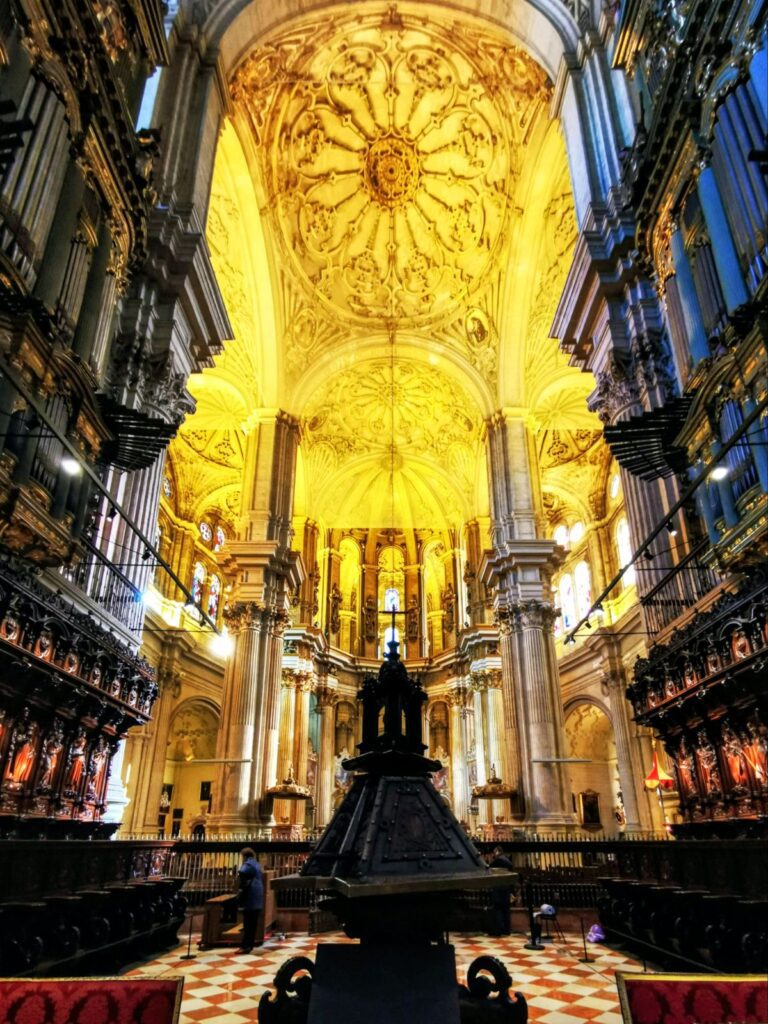
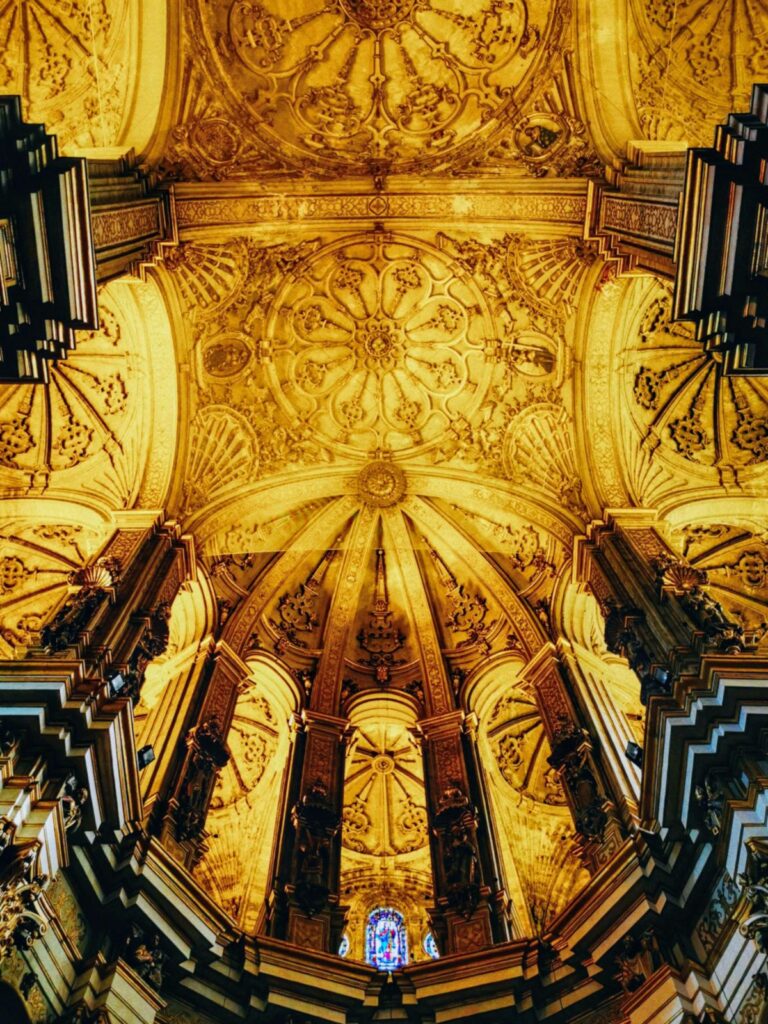
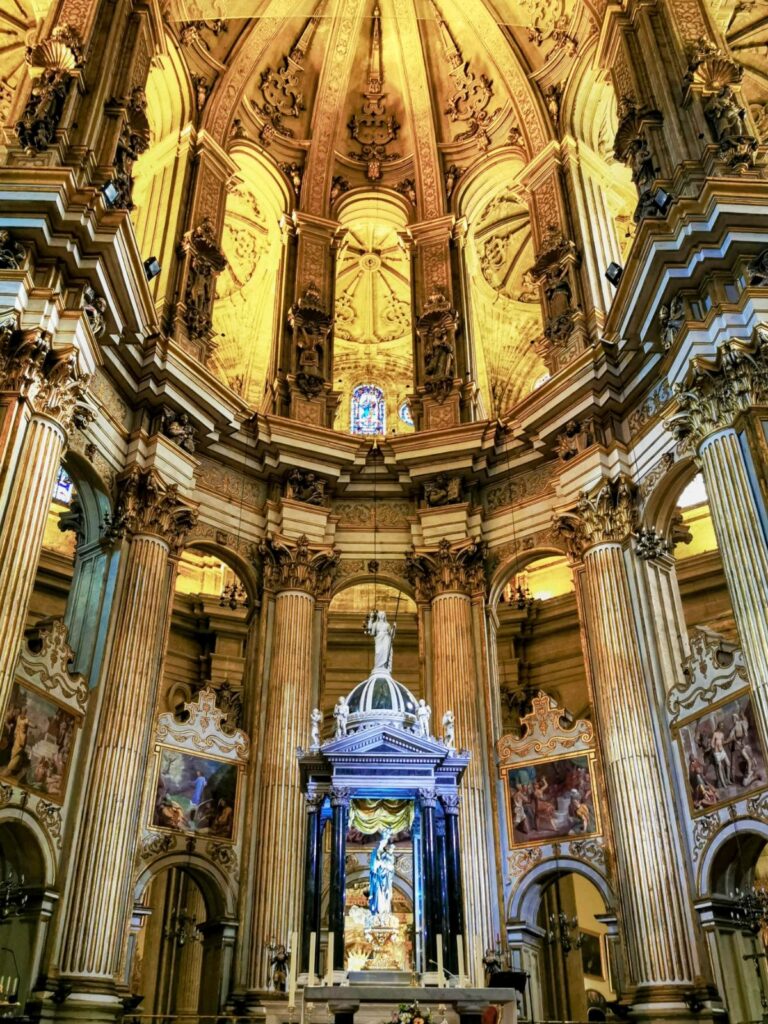
14. Church of Saint-Germain-des-Prés, Paris, France
Historic Significance: The Church of Saint-Germain-des-Prés is one of the oldest churches in Paris, with origins dating back to the 6th century. It was originally founded as an abbey by the Merovingian King Childebert I and has played a significant role in the religious and cultural life of Paris over the centuries.
Architectural Style: The church showcases a mix of architectural styles due to various renovations and reconstructions throughout its history. Primarily, it features Romanesque and early Gothic elements, reflecting its long-standing heritage.
Ceiling and Interior: The ceiling of Saint-Germain-des-Prés is notable for its striking frescoes and painted decorations. These vibrant artworks were restored in the 19th century by the artist Hippolyte Flandrin, who was a student of the famous painter Ingres. The ceiling features colorful, intricate patterns and religious scenes that enhance the spiritual ambiance of the church.

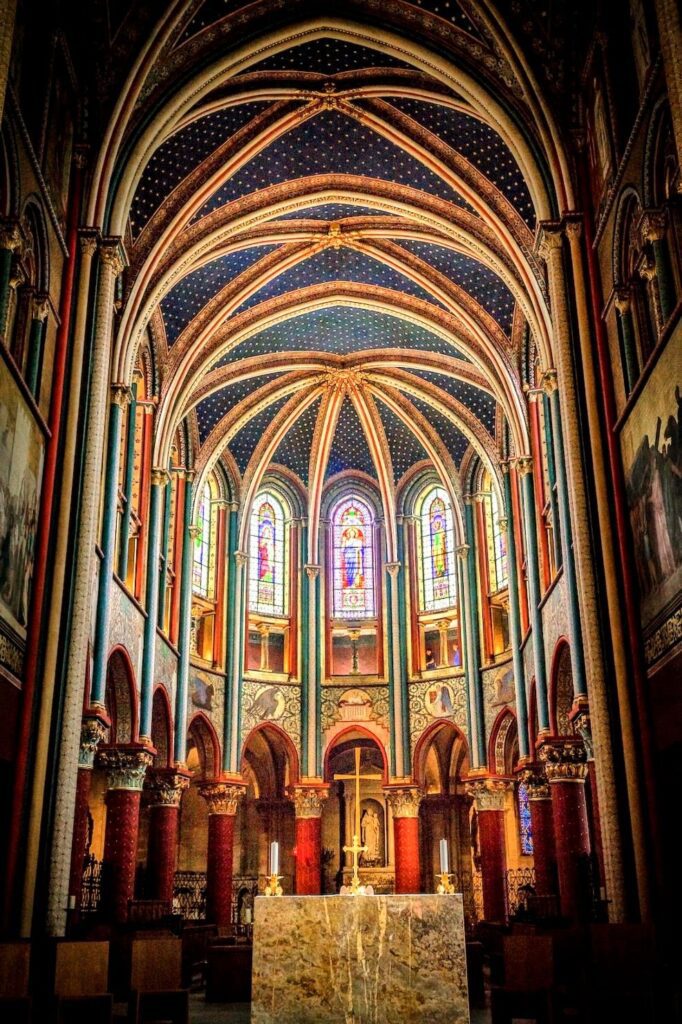
15. St. Stephen’s Basilica, Budapest, Hungary
Historical Significance: St. Stephen’s Basilica, located in Budapest, is one of the most important religious buildings in Hungary. Named in honor of Stephen I, the first King of Hungary, the basilica is a symbol of the nation’s Christian heritage and a prominent architectural landmark.
Architectural Style: The basilica showcases a blend of Neo-Classical and Neo-Renaissance architectural styles. Its construction began in 1851 and was completed in 1905, involving multiple architects, including József Hild, Miklós Ybl, and József Kauser.
Ceiling Structure: The interior of St. Stephen’s Basilica is renowned for its magnificent dome, which rises to a height of 96 meters (315 feet), symbolizing the year 896 when the Magyars settled in the Carpathian Basin. The ceiling and dome are adorned with beautiful frescoes by renowned Hungarian artist Károly Lotz. These frescoes depict various scenes from the life of St. Stephen and other biblical themes, featuring vibrant colors and intricate details that create a heavenly atmosphere.
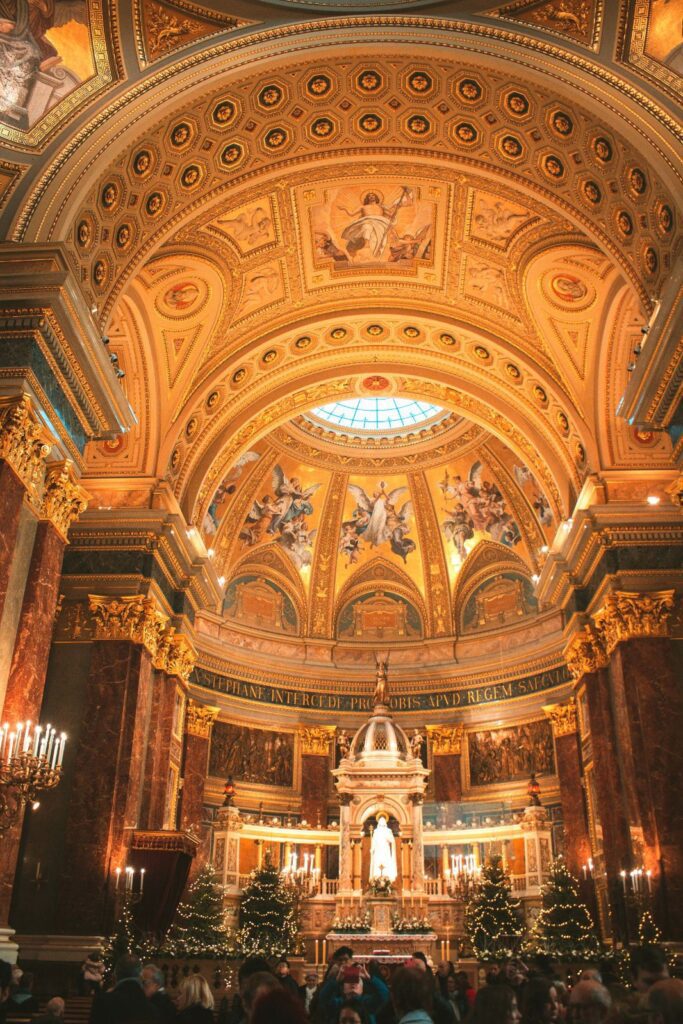
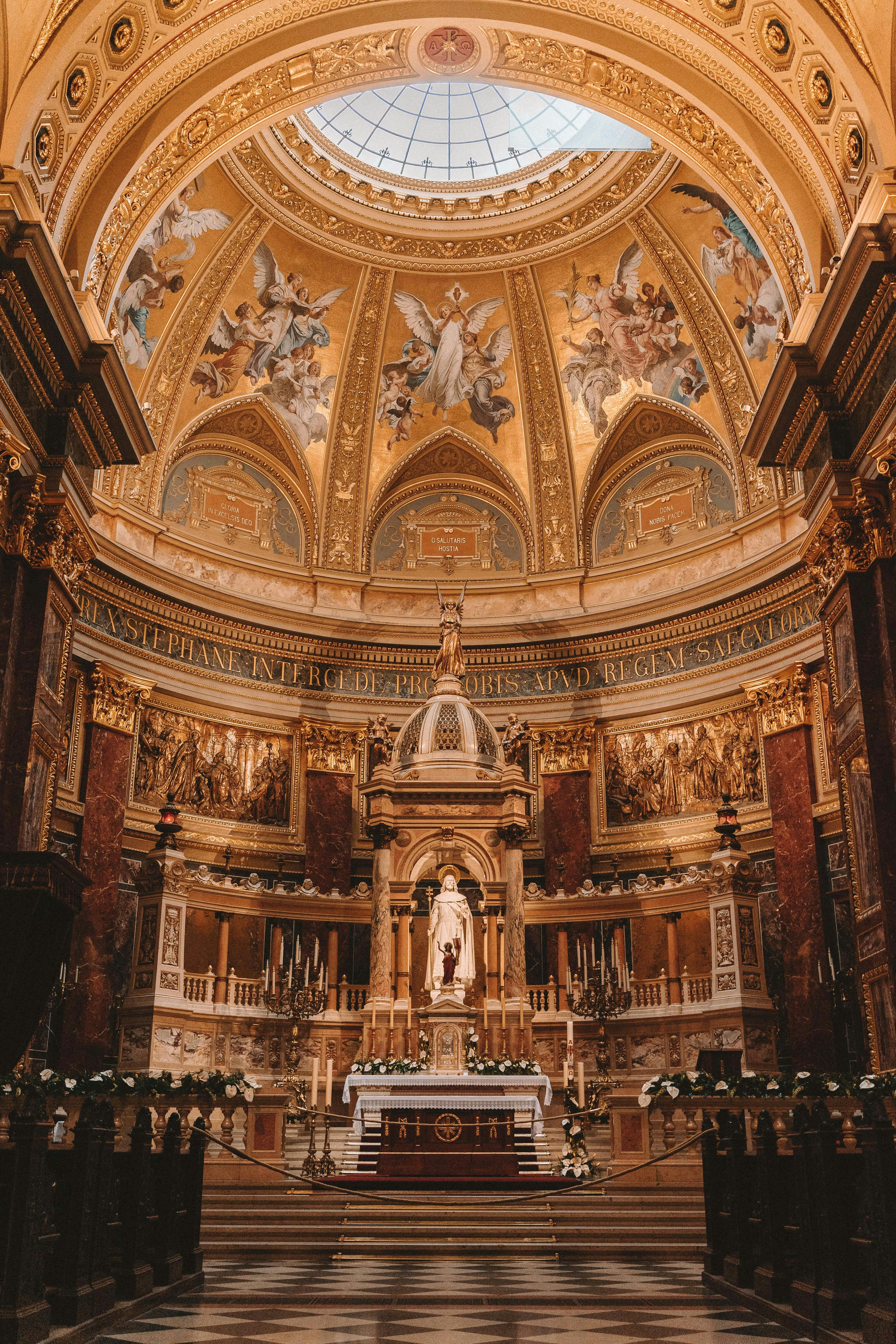
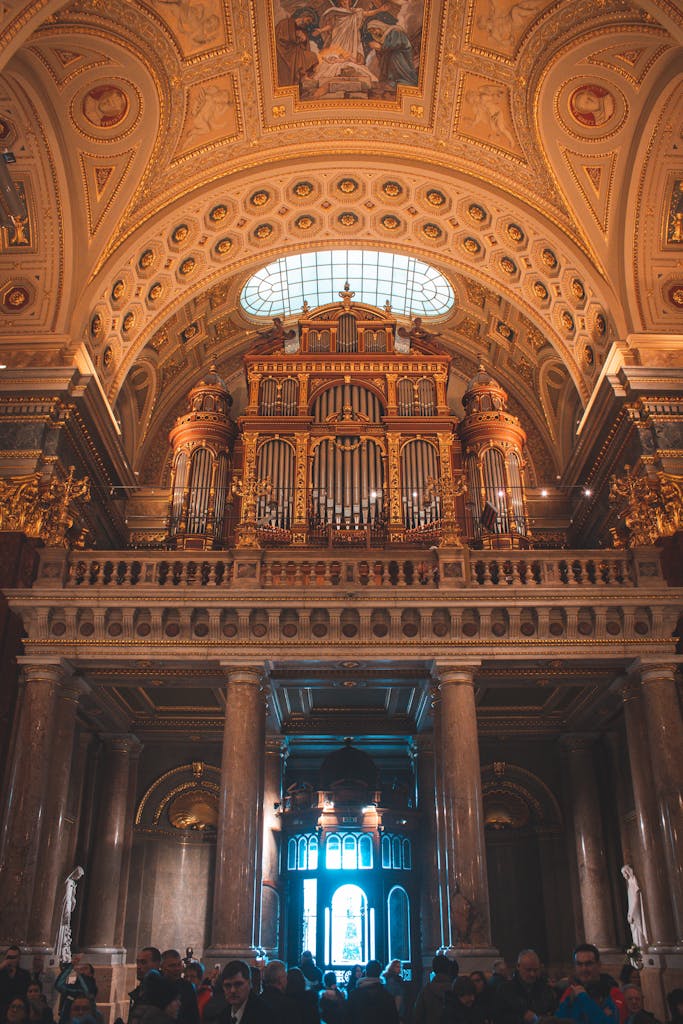

16. Basilica of San Francisco el Grande, Madrid, Spain
Historical Significance: The Basilica of San Francisco el Grande, officially known as the Royal Basilica of San Francisco el Grande, is a major architectural landmark in Madrid, Spain. It was built in the late 18th century on the site of a former Franciscan friary, with construction completed in 1784. The basilica is dedicated to St. Francis of Assisi and is known for its impressive size and artistic treasures.
Architectural Style: The basilica features a Neoclassical architectural style with Baroque elements. It was designed by architect Francesco Sabatini and later completed by Francisco Cabezas and Miguel Fernández.
Ceiling and Dome: The most striking feature of the basilica is its enormous dome, which is one of the largest in the Christian world, with a diameter of 33 meters (108 feet). The interior of the dome is adorned with beautiful frescoes by Spanish artists, including Francisco Goya, Mariano Salvador Maella, and José del Castillo. These frescoes depict scenes from the life of the Virgin Mary and various saints, creating a visually stunning and spiritually uplifting experience for visitors.
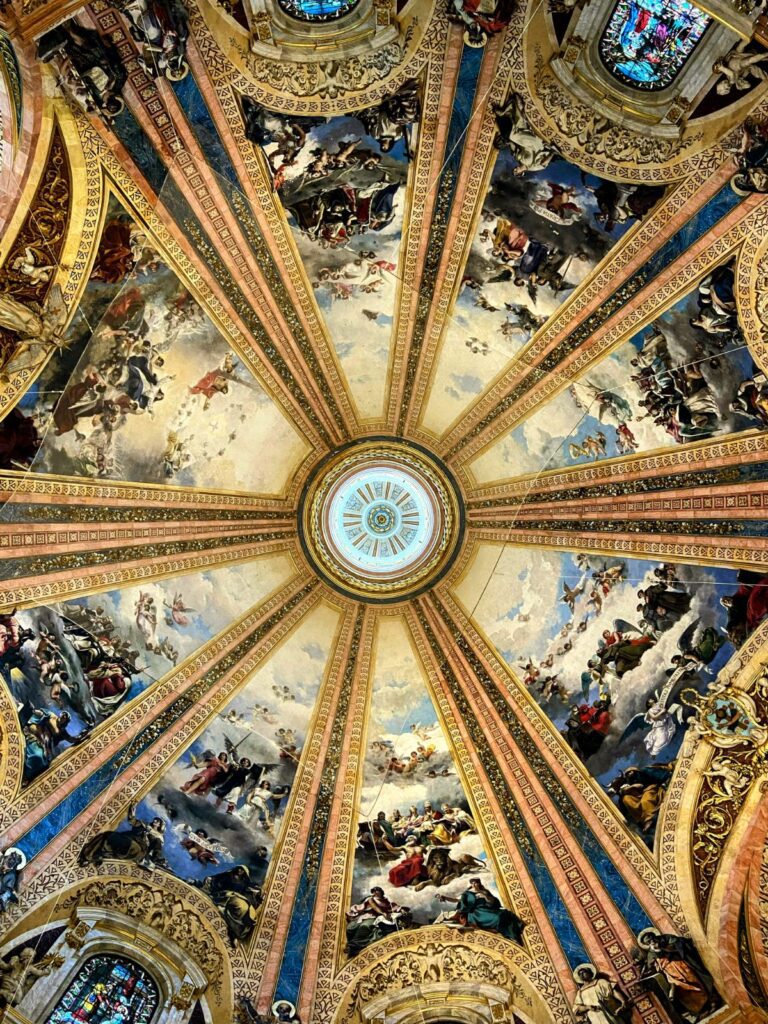
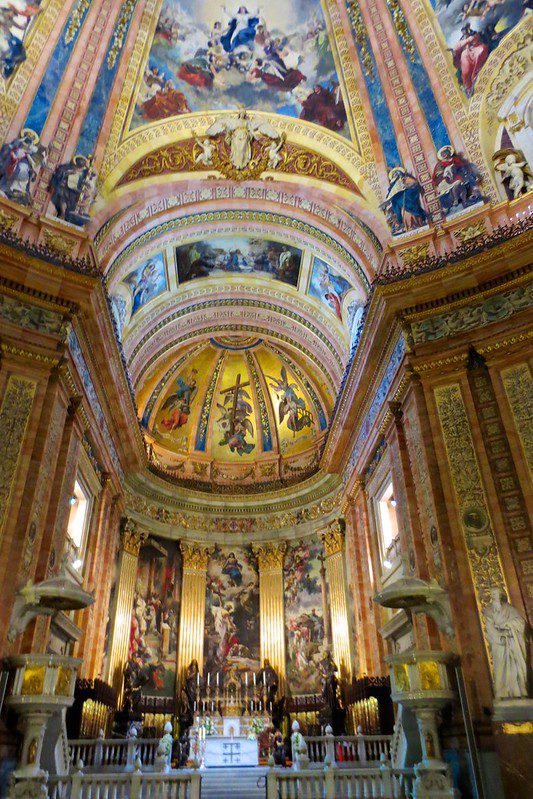
17. Ely Cathedral, Ely, England
Historical Significance: Ely Cathedral, also known as the Cathedral Church of the Holy and Undivided Trinity, is a majestic Gothic structure with a rich history dating back to its founding as a monastery in 672 AD by St. Etheldreda. The current cathedral was begun in 1083 and completed in 1351, serving as a significant religious site and architectural marvel for centuries.
Architectural Style: Ely Cathedral is primarily constructed in the Norman style, with later additions in the Early English Gothic and Decorated Gothic styles. The cathedral is known for its impressive length, soaring towers, and intricate stonework.
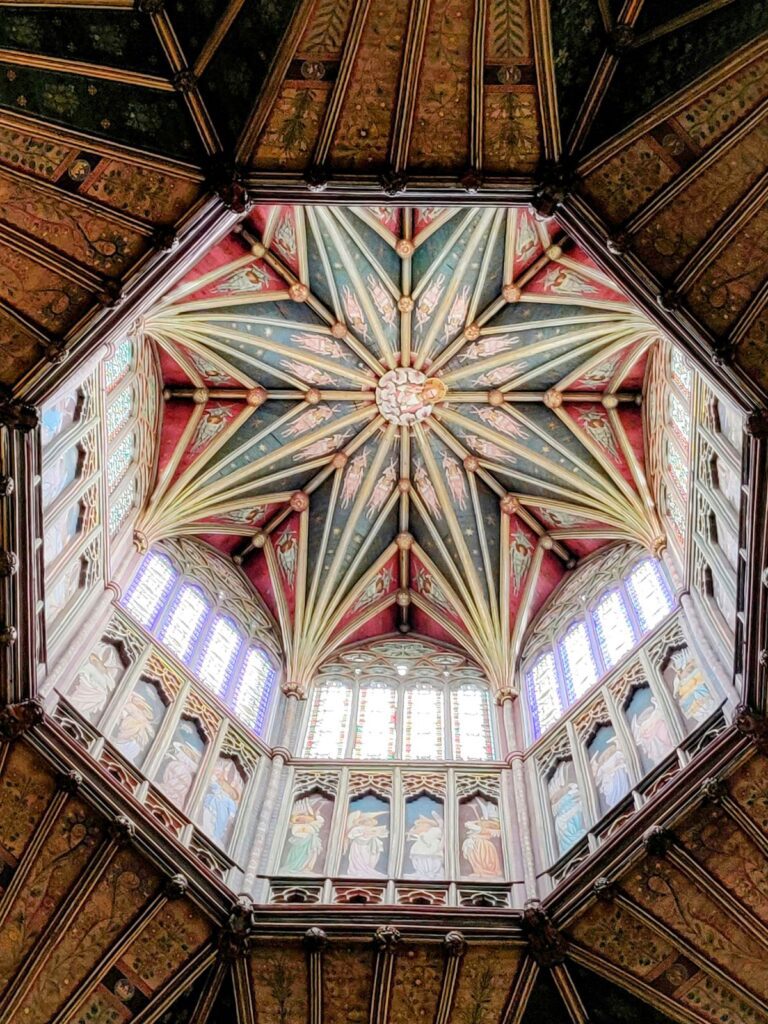
18. Mosque-Cathedral of Córdoba, Spain
Historical Significance: The Mosque-Cathedral of Córdoba, also known as the Mezquita-Catedral, is one of the most remarkable examples of Islamic architecture in Spain and a UNESCO World Heritage site. Originally built as a mosque in the 8th century by the Umayyad dynasty, it was converted into a Christian cathedral in the 13th century following the Reconquista.
Architectural Style: The building is an exquisite blend of Islamic and Christian architectural styles, reflecting its diverse history. The original mosque features include horseshoe arches, an extensive hypostyle hall with over 850 columns made of jasper, onyx, marble, and granite, and intricate geometric and vegetal decoration typical of Islamic art. The Christian additions include Gothic, Renaissance, and Baroque elements, most notably the insertion of a Renaissance cathedral nave in the heart of the former mosque.
Ceiling Structure:
- Hypostyle Hall: The original mosque’s hypostyle hall is characterized by a unique double-arched design. The lower arches are horseshoe-shaped, and the upper arches are semi-circular, creating an impression of height and lightness. The ceiling of the hall is relatively low but is elevated by this ingenious double-arch structure, creating a forest of columns that is both disorienting and awe-inspiring.

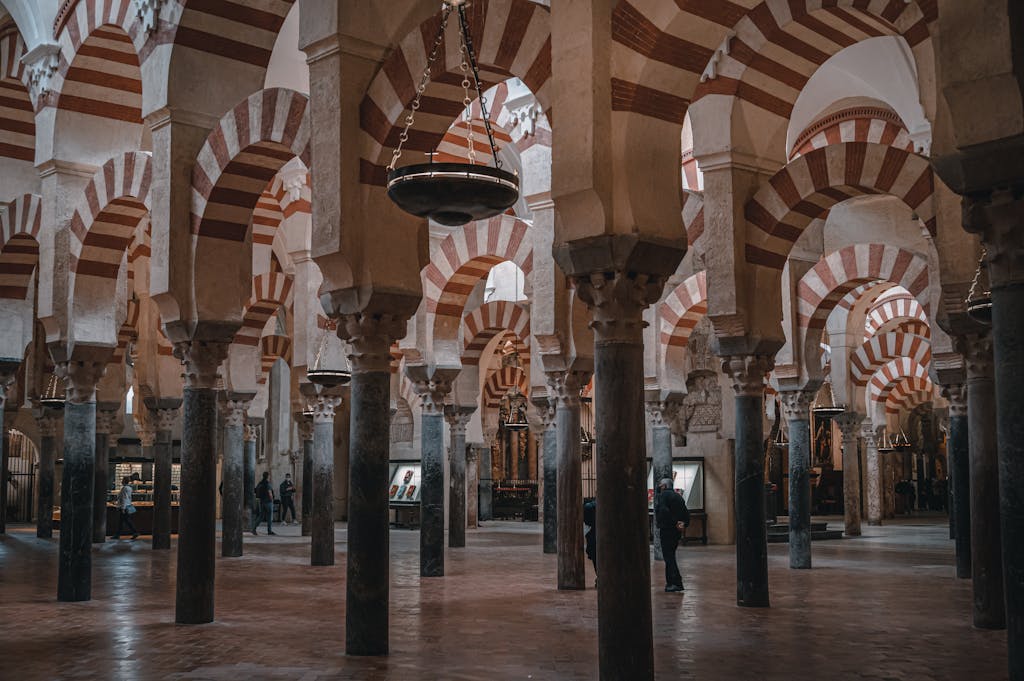
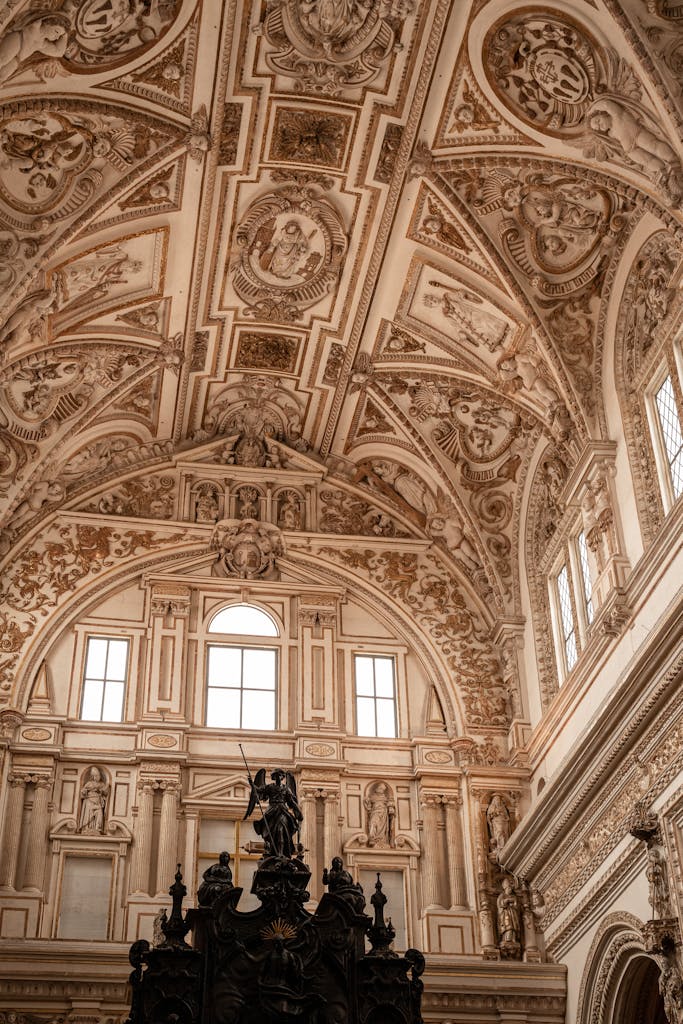
19. St. Isaac’s Cathedral, St. Petersburg, Russia
Historical Significance: St. Isaac’s Cathedral is a majestic architectural masterpiece located in St. Petersburg, Russia. It was commissioned by Tsar Alexander I in the early 19th century as a tribute to Russia’s victory over Napoleon, and it took over 40 years to complete, from 1818 to 1858.
Architectural Style: The cathedral is a prime example of Russian Neoclassical architecture, designed by the French architect Auguste de Montferrand. It features a monumental façade adorned with Corinthian columns, a massive central dome, and a golden dome that dominates the skyline of St. Petersburg.
Ceiling: The highlight of St. Isaac’s Cathedral is its enormous central dome, which rises to a height of 101.5 meters (333 feet) and is plated with pure gold. The dome is supported by a ring of massive granite columns and is topped with a lantern and a cross, symbolizing the Christian faith.
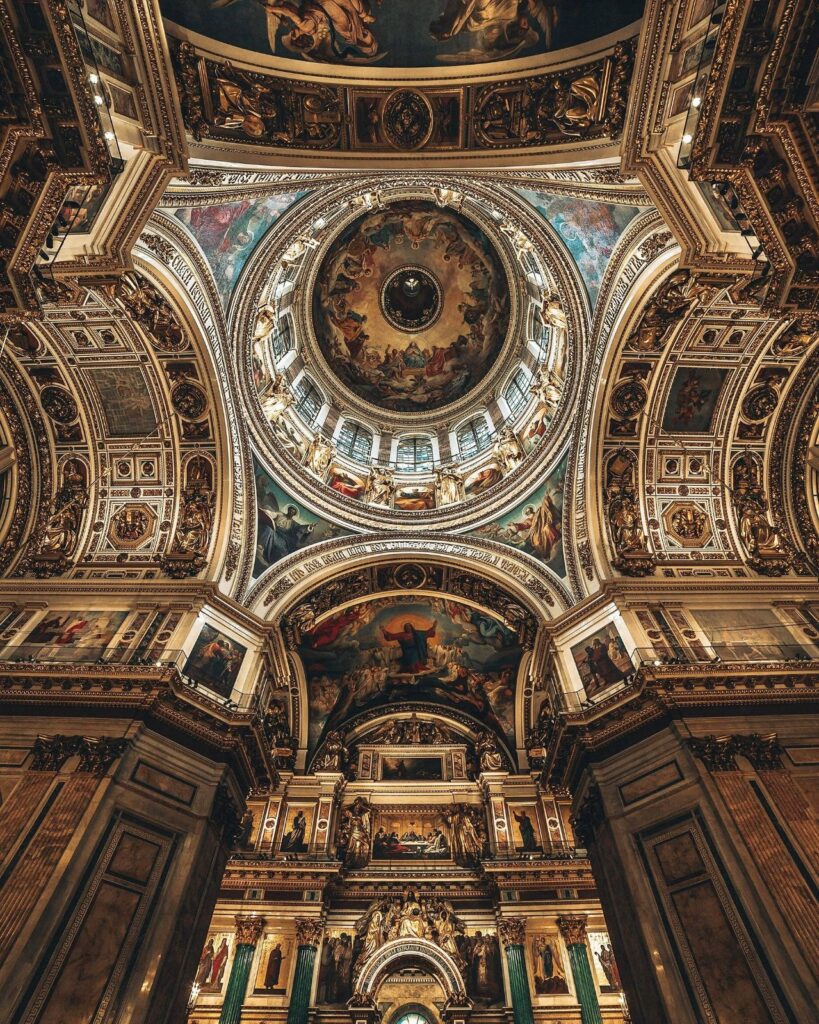

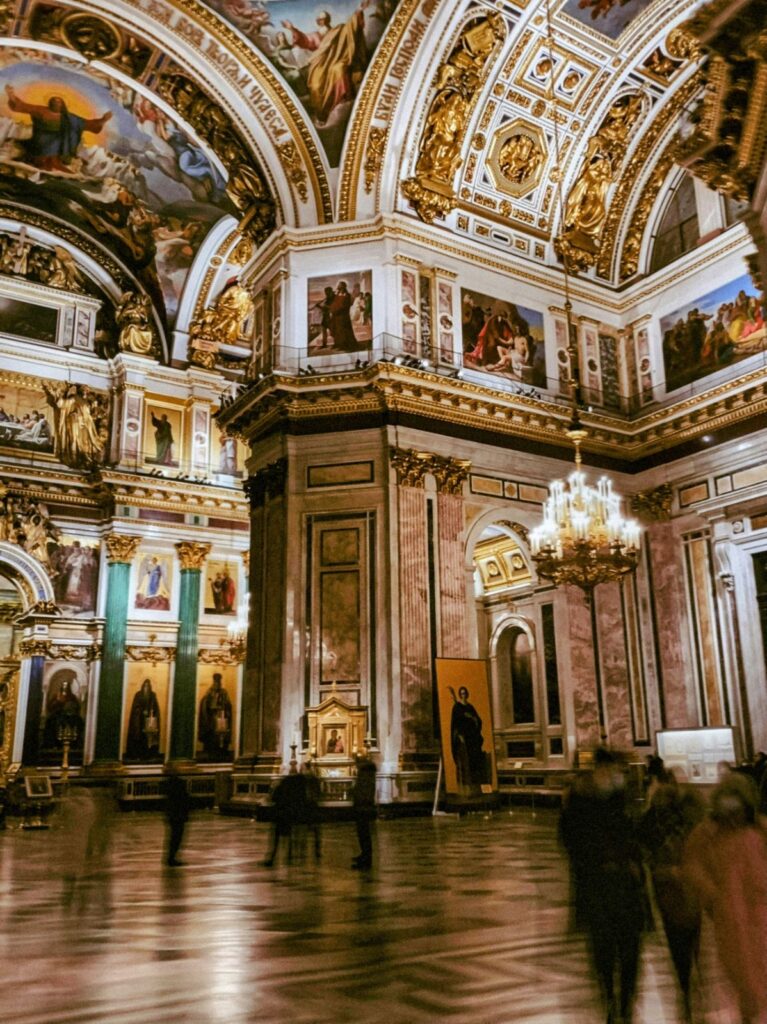
20. San Carlo al Corso, Rome, Italy
Historical Significance: San Carlo al Corso is a prominent Roman Catholic church located on the Via del Corso in Rome, Italy. It is dedicated to Saint Charles Borromeo, a cardinal and archbishop of Milan who was canonized in 1610. The church serves as a national church for the Lombards in Rome. The construction of San Carlo al Corso began in 1612 and was completed in 1672, with contributions from several renowned architects, including Onorio Longhi, Martino Longhi the Younger, and Pietro da Cortona.
Architectural Style: The church is a fine example of Baroque architecture, characterized by its grandeur, intricate details, and dramatic use of space and light. The façade is elegant and imposing, with Corinthian columns and a grand entrance that invites worshippers and visitors alike.
Ceiling Structure:
- Dome: The most striking feature of San Carlo al Corso is its magnificent dome. The dome is decorated with stunning frescoes painted by Giacinto Brandi, depicting the “Glory of Paradise.” These frescoes are vibrant and dynamic, illustrating scenes of angels, saints, and heavenly glory. The use of light and shadow in the frescoes creates a sense of depth and movement, enhancing the overall impact of the dome.
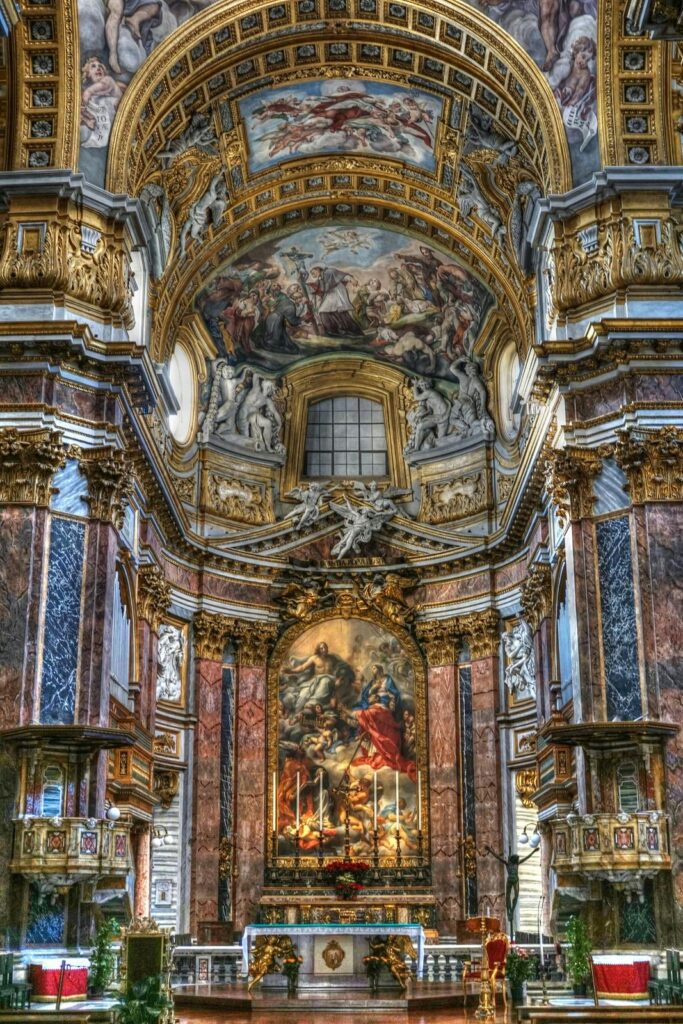
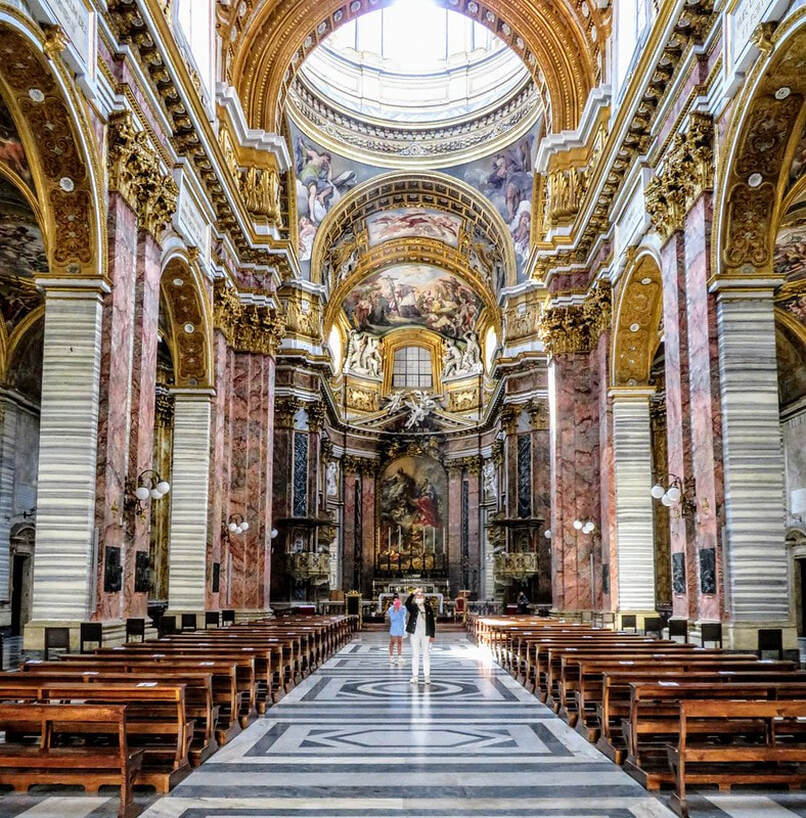
21. The Basilica of St. Francis of Assisi, Assisi, Italy
Historical Significance: This basilica is the mother church of the Roman Catholic Order of Friars Minor, commonly known as the Franciscans. It is a UNESCO World Heritage Site and a major pilgrimage site.
Ceiling Structure: The Upper Basilica features frescoes by Giotto and his school, depicting the life of St. Francis. The ceiling is adorned with vibrant colors and intricate designs, creating a heavenly atmosphere that complements the basilica’s spiritual significance.
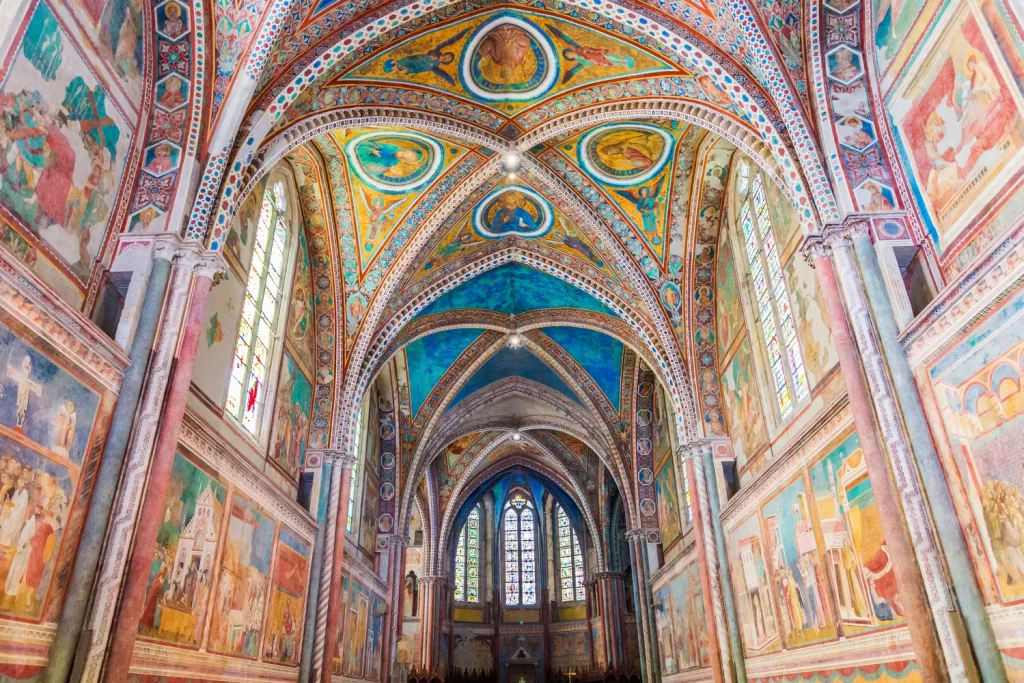
22. Medici Chapel, Florence, Italy
Historical Significance: The Medici Chapel, part of the Basilica of San Lorenzo in Florence, Italy, serves as the burial place of the Medici family, one of the most powerful and influential families in Renaissance Florence. The chapel consists of two main parts: the Sagrestia Nuova (New Sacristy) and the Cappella dei Principi (Chapel of the Princes). The Sagrestia Nuova was designed by Michelangelo in the early 16th century, while the Cappella dei Principi was initiated in the early 17th century and completed in the 18th century.
Architectural Style: The Medici Chapel showcases a combination of Renaissance and Baroque architectural styles. The Sagrestia Nuova reflects Michelangelo’s mastery of Renaissance art and architecture, while the Cappella dei Principi exemplifies the opulence and grandeur of Baroque design.
Ceiling Structure:
- Sagrestia Nuova (New Sacristy):
- Dome: The ceiling of the Sagrestia Nuova features a dome designed by Michelangelo. The dome is relatively simple compared to the more elaborate Baroque style, emphasizing geometric precision and classical harmony. The dome’s interior is adorned with coffering and a central lantern that allows light to flood the space, highlighting the sculptures and architectural details below.
- Sculptures: Michelangelo’s sculptural masterpieces, including the allegorical figures of Dawn and Dusk, Night and Day, and the tombs of Lorenzo and Giuliano de’ Medici, are prominently displayed under the dome. These sculptures are integrated into the architectural design, creating a cohesive and harmonious space.
Cultural and Religious Importance: The Medici Chapel serves as a testament to the Medici family’s power, wealth, and patronage of the arts. It is a significant cultural and historical landmark in Florence, attracting scholars, art historians, and tourists. The chapel is also an important religious site, as it houses the remains of several members of the Medici family, who played a crucial role in the political and cultural development of Renaissance Florence.
The Medici Chapel, with its stunning domes, intricate frescoes, and rich ornamentation, exemplifies the artistic and architectural achievements of the Renaissance and Baroque periods. It remains a symbol of the Medici family’s enduring legacy and their contributions to the cultural heritage of Florence.
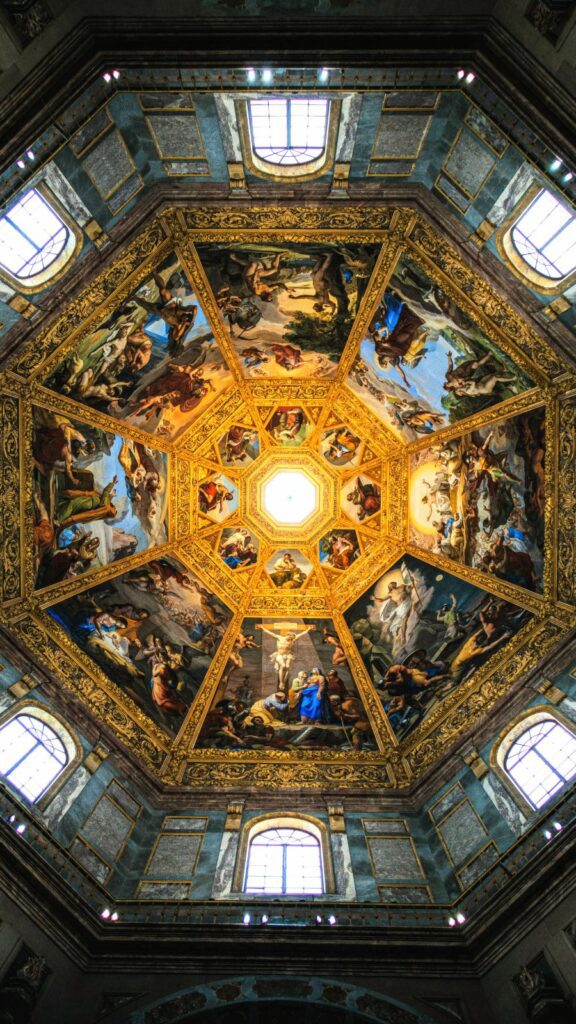
23. Notre-Dame Basilica, Montreal, Canada
Historical Significance: Notre-Dame Basilica is a Gothic Revival church located in the historic district of Old Montreal, Quebec, Canada. It was built between 1824 and 1829 and designed by the Irish-American architect James O’Donnell. This basilica is one of the most beautiful and significant religious sites in Canada, attracting millions of visitors each year.
Architectural Style: The basilica is a prime example of Gothic Revival architecture, characterized by its pointed arches, ribbed vaults, and flying buttresses. The exterior features twin towers, known as the Perseverance and Temperance towers, which add to the church’s imposing and majestic appearance.
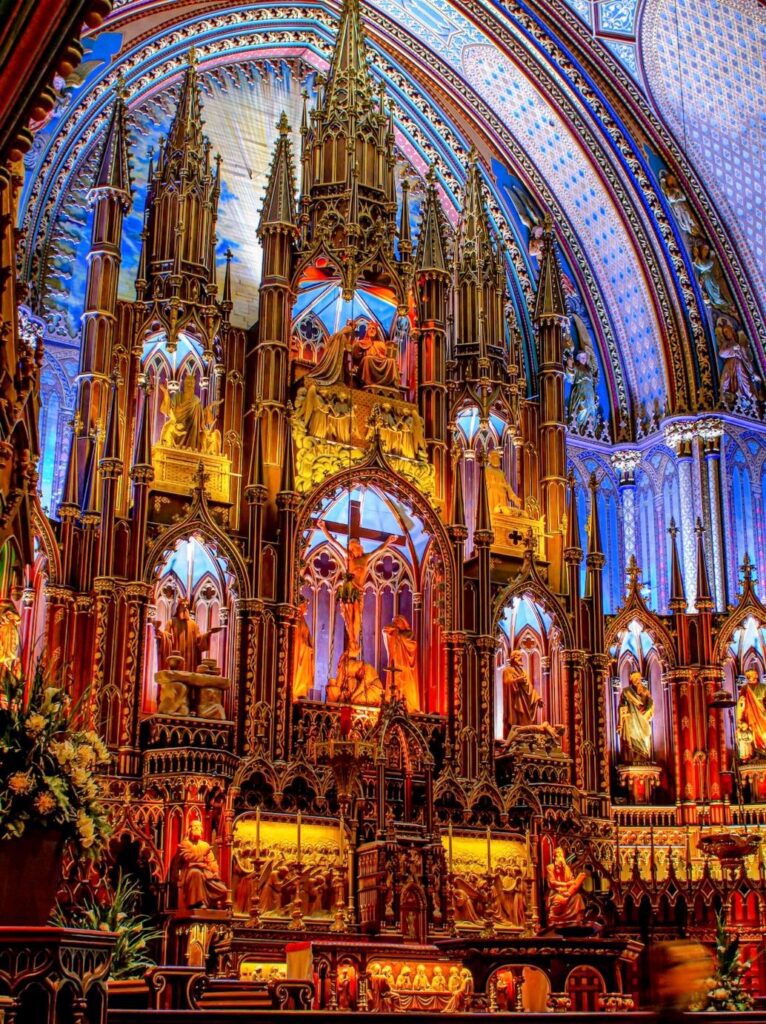
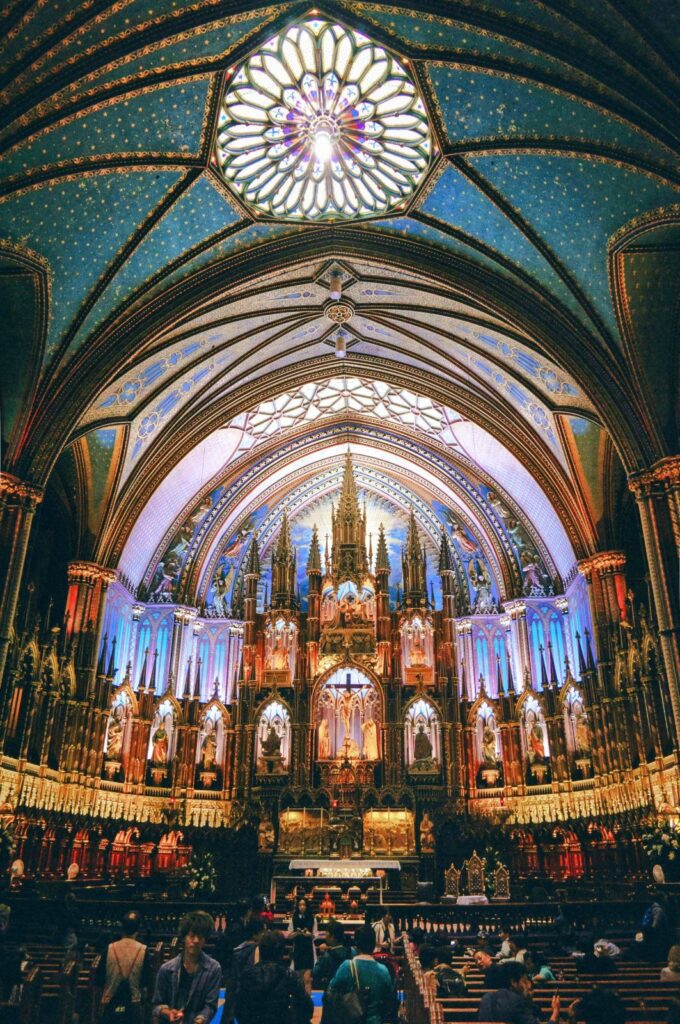
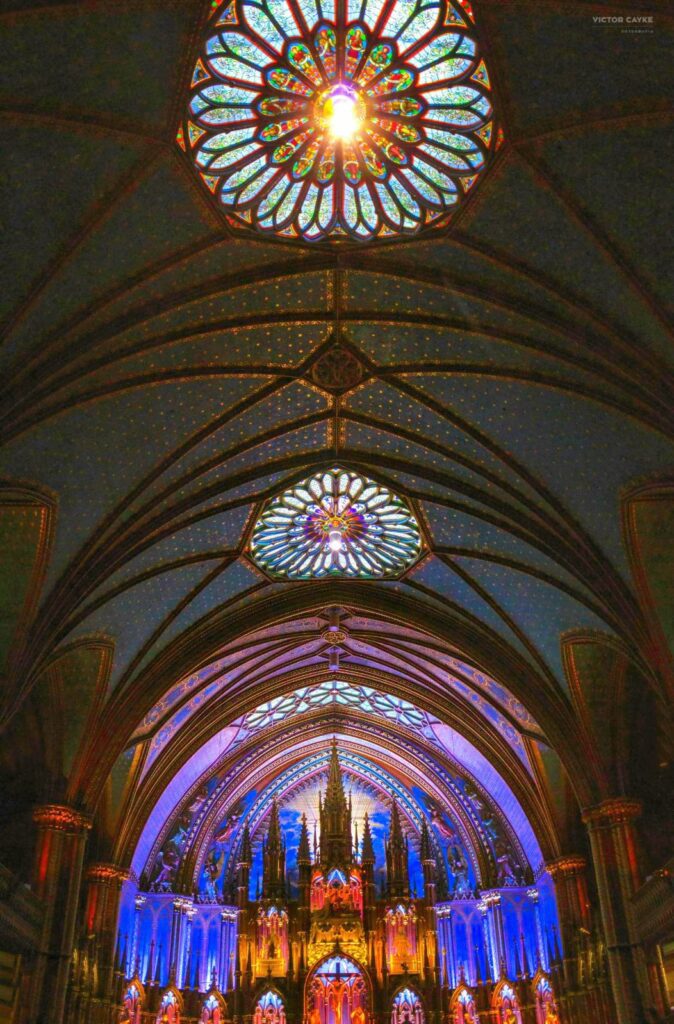
24. Templo de Santo Domingo de Guzmán, Oaxaca, Mexico
Historical Significance: The Templo de Santo Domingo de Guzmán is a historic Baroque ecclesiastical building located in Oaxaca, Mexico. It was constructed between 1575 and 1731 by the Dominican Order and is part of a larger complex that includes a convent and the Museo de las Culturas de Oaxaca. This temple is one of the most significant and impressive examples of colonial architecture in Mexico, reflecting the rich cultural heritage and history of Oaxaca.
Architectural Style: The church is designed in the Baroque style, known for its elaborate and ornate decorations, dramatic use of light and shadow, and intricate details. The facade of the church is adorned with carved stone figures, reliefs, and motifs typical of Baroque architecture.
Ceiling Structure:
- Lavish Ornamentation: The ceilings of the Templo de Santo Domingo de Guzmán are renowned for their lavish ornamentation. The intricate stucco work, gilded decorations, and detailed reliefs create a visually stunning and richly textured surface that draws the eye upward.
- Rosary Chapel Ceiling: One of the most remarkable features of the church is the ceiling of the Rosary Chapel (Capilla del Rosario). This ceiling is covered with elaborate gold leaf and stucco decorations, featuring a multitude of religious and symbolic motifs. The central figure of the Virgin of the Rosary is surrounded by angels, saints, and intricate floral patterns, all rendered in exquisite detail.
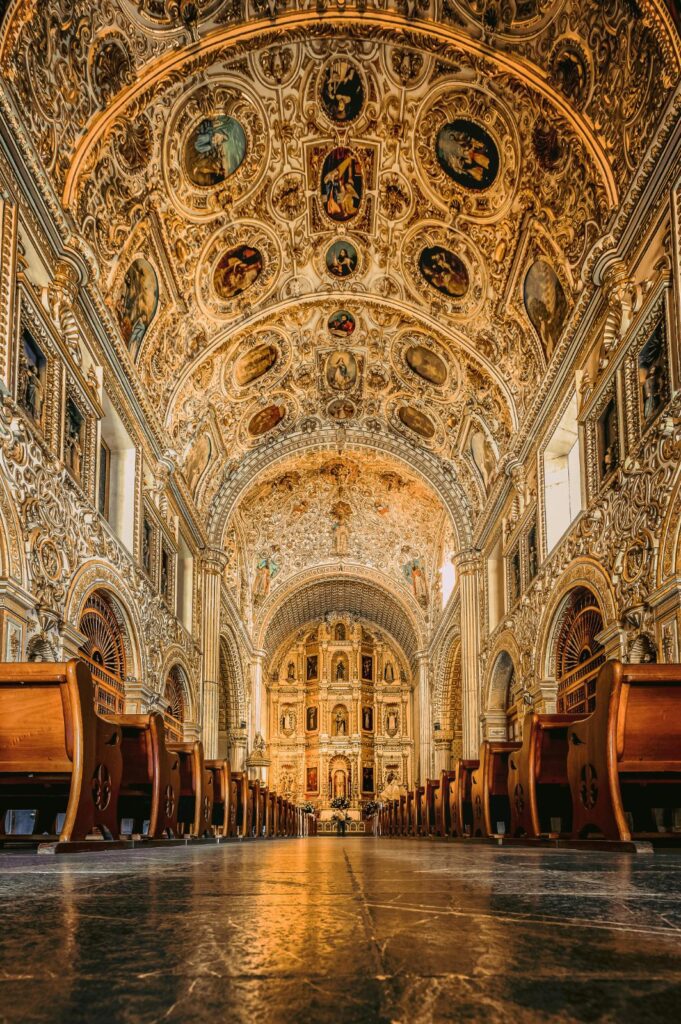
And lastly…
25. Basilica of the Sagrada Familia, Barcelona, Spain
Gaudí’s Vision
Historical Significance: The Basílica de la Sagrada Família, commonly known as the Sagrada Família, is an iconic and unfinished basilica located in Barcelona, Spain. Designed by the renowned Catalan architect Antoni Gaudí, its construction began in 1882 and continues to this day. The basilica is a UNESCO World Heritage Site and one of the most visited landmarks in Spain.
Architectural Style: The Sagrada Família is a unique blend of Gothic and Art Nouveau styles, heavily influenced by Gaudí’s distinctive and innovative approach to architecture. Gaudí devoted much of his life to the project, infusing it with intricate details and symbolic elements that reflect his deep Christian faith.
Ceiling Structure: Nave Ceiling: The interior ceiling of the Sagrada Família is one of its most striking features. The ceiling is supported by tree-like columns that branch out as they rise, creating the effect of a forest canopy. This design not only supports the structure but also creates an ethereal and naturalistic atmosphere inside the basilica. The columns and ceiling are made of different materials and colors, adding to the overall visual impact.
Antoni Gaudí’s unfinished masterpiece, the Sagrada Familia, boasts a ceiling designed to resemble a forest canopy, with intricate branching columns and star-like shapes that filter light in ethereal ways.

These photos down below were taken in April 2024 by Jhoanne M. my travel enthusiast friend who celebrated her birthday in Spain and Italy and travels everywhere, she should be a Vlogger instead of a Physical Therapist..lol..
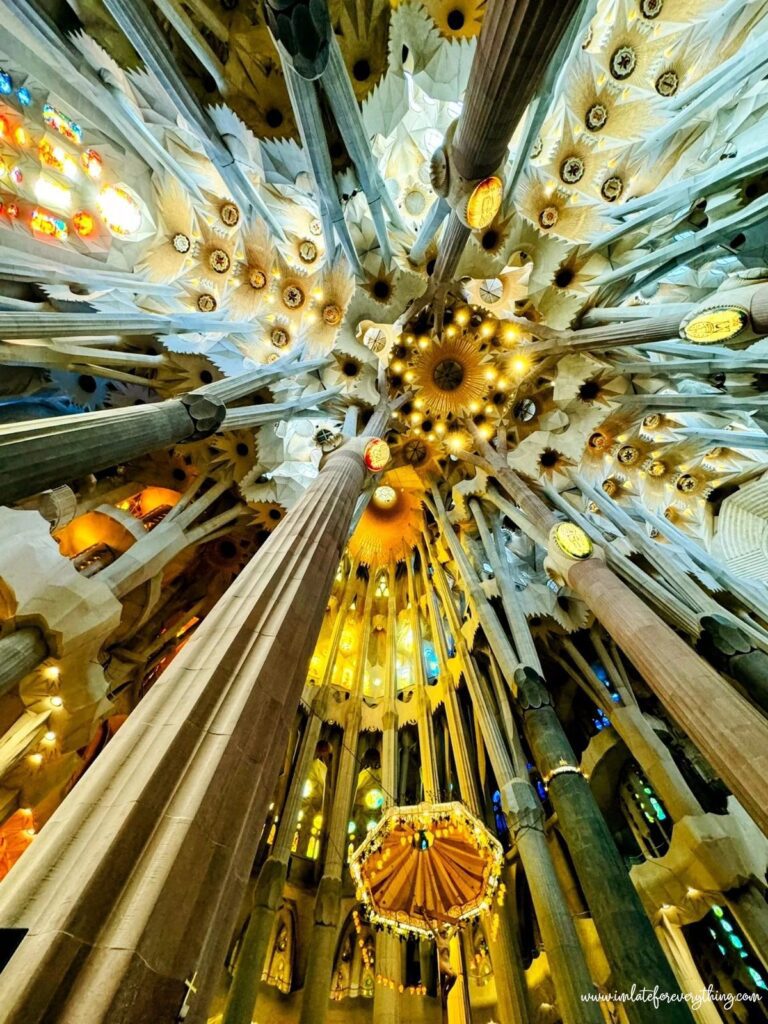
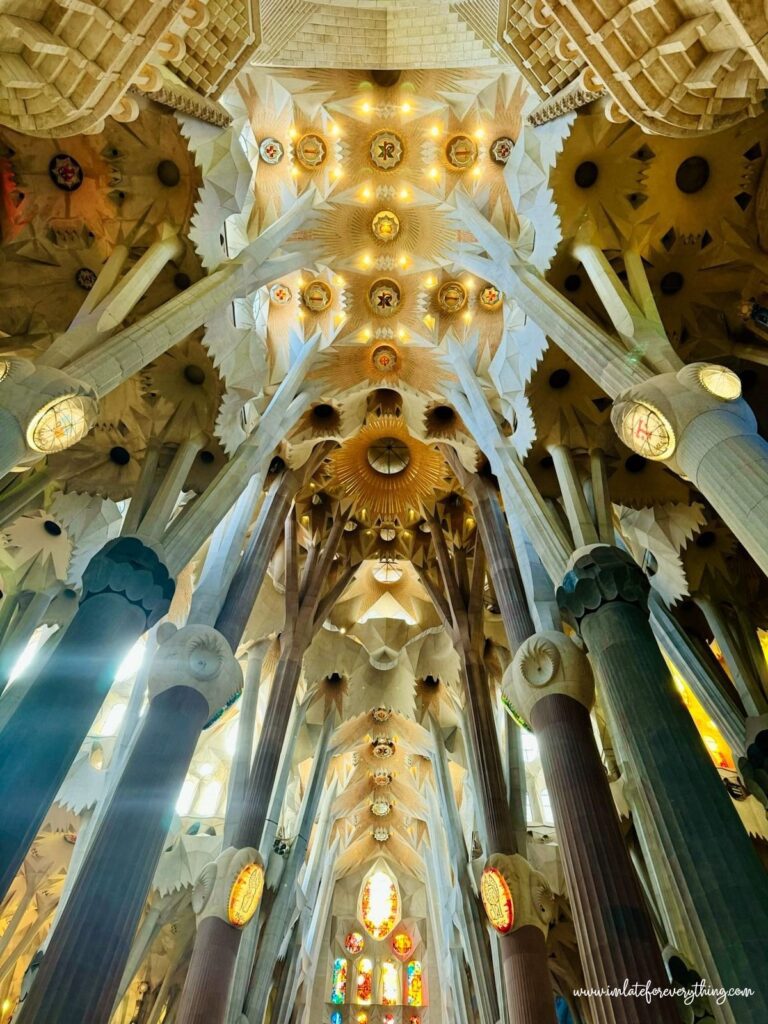

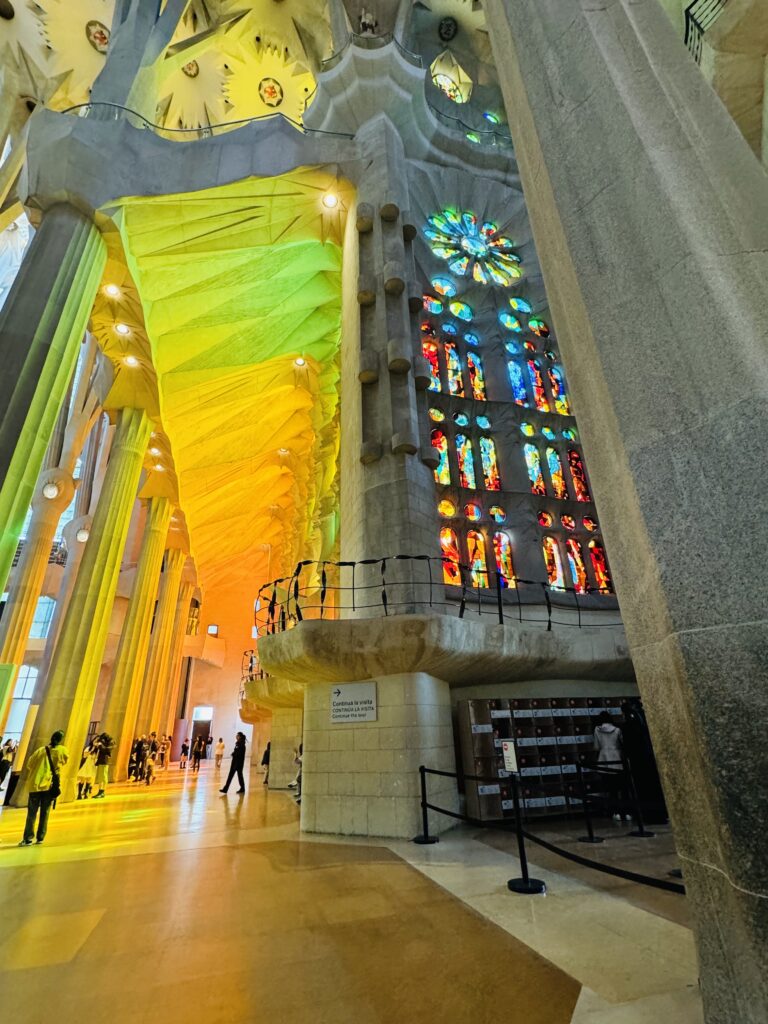
As we conclude this journey through some of the world’s most breathtaking places, I hope these glimpses have ignited a sense of wanderlust within you. Whether you dream of exploring ancient cathedrals in Europe, marveling at natural wonders across continents, or discovering hidden gems in your own backyard like me enjoying the sunsets, remember that the world is vast and waiting to be explored.
Which of these most beautiful church ceilings in the world inspired you to travel and see in person? Or how many of these churches have you visited already? I hope these beautiful church ceiling photos helps you decide where to go next!!
Pls. make sure to comment down below.
Let these beautiful places be more than just images—they are invitations to create your own adventures, to immerse yourself in different cultures, and to embrace the wonders of our planet. So pack your bags, set out on new paths, and let each journey awaken your curiosity and enrich your soul.
Because in the end, the true beauty of travel lies not only in the destinations we visit but in the experiences, memories, and connections we make along the way and don’t forget to take beautiful photos!! Be a photographer enthusiasts!! Bon voyage and may your travels be filled with joy, discovery, and moments that take your breath away!!
Til Next Time,
Sheila
